
Wearable Health Monitor Solutions
Analog Devices’ optical, impedance, bio-potential, and motion sensor technologies and signal conditioning expertise empower you to design the most innovative wearable health monitoring devices, such as fitness bands, sports watches, and pedometer chest patches. https://www.analog.com/en/products/aducm350.html We provide the quick evaluation of the hardware and embedded firmware for blood oxygenation (SpO2), heart rate (HR), respiration rate (RR), impedance cardiography (ICG), body impedance analysis (BIA), and skin/ambient temperatures for wearable health monitors. They shorten the development time through an open-source design. It includes clinical grade-sensing fidelity and provides access to raw, pre-processed data and processed data that could enable medical researchers to build a model or insight around a disease state, as well as non-invasively measures every human body vital sign available on the chest. These full solutions are made up of several cutting-edge sensors including power management devices, temperature sensors, analog front end (AFE), and new MCU with algorithms.
Value and Benefits
Our optical, impedance, bio-potential, and temperature technologies offer the highest sensitivity to accurately extract the weakest signals. Low power consumption in our sensing and motion sensor technologies and power management solutions allow you to maximize the battery life of wearables and integrate fuel gauging, power sequencing, and haptics to ease system design. Our open-source reference designs for wrist-worn and chest-based wearable systems accelerate customer development cycles.


Accurately extracts weak signals


Maximizes battery life


Eases system design with seamless integration
Featured Products
MAX30009

The MAX30009 is a complete Bioimpedance (BioZ) Analog Front-End (AFE) solution for wearable applications. It offers high performance for fitness, wellness, and clinical applications, and ultra-low power for long battery life. The BioZ receive channel has Electrostatic Discharge (ESD) protection, Electromagnetic Interference (EMI) filtering, internal lead-biasing, DC leads-off detection, DRVN lead-off detection, and ultra-low power lead-on detection during standby mode. The BioZ receive channel also has high input impedance, low noise, high Common-Mode Rejection Ratio (CMRR), programmable gain, various low-pass and high-pass filter options, and two high resolution analog-to-digital converters for simultaneous I and Q acquisition.
The BioZ transmit channel has a sine-wave current generator to drive AC currents into the body with a wide frequency range of 16Hz to 500kHz and a wide magnitude range of of 16nARMS to 1.28mARMS. The transmit channel can also operate in the sine-wave voltage and H-bridge modes. The flexible input/output MUX allows for both bipolar and tetrapolar measurements with multiple sets of electrodes.
For measurements requiring high absolute impedance accuracy such as Bioimpedance Analysis/Spectroscopy (BIA/BIS) and Automated External Defibrillator (AED) body impedance, the MAX30009 offers several calibration options. An external precision resistor can be connected to the four-wire calibration port for the highest accuracy. Internal trimmed resistors also provide high accuracy.
The PLL-based timing subsystem allows for a wide range of fine-tuned stimulus and sampling frequencies, and can be synchronized with other Analog Devices biosensors for simultaneous data collection.
The MAX30009 is available in a 2.03mm x 2.03mm, 25-bump Wafer-Level Package (WLP), operating over the -40°C to +85°C temperature range.
Applications
- Wearable Fitness, Wellness, and Medical Devices
- Multifrequency Body Composition Analyzers
- Non-Invasive Hemodynamic Monitors
- Automatic External Defibrillators
- Optimized Performance to Accurately Detect:
- Respiration Rate
- Galvanic Skin Response/Electrodermal Activity
- Bioimpedance Spectroscopy
- Body Composition and Fluid Analysis
- Impedance Cardiography and Plethysmography
Applications
Healthcare Solutions
- Activity Tracking and Fall Detection Solutions
- Respiration Rate Measurement Solutions
- Electrocardiogram (ECG) Measurement Solutions
- Wearable Health Monitor Solutions
MAX30208
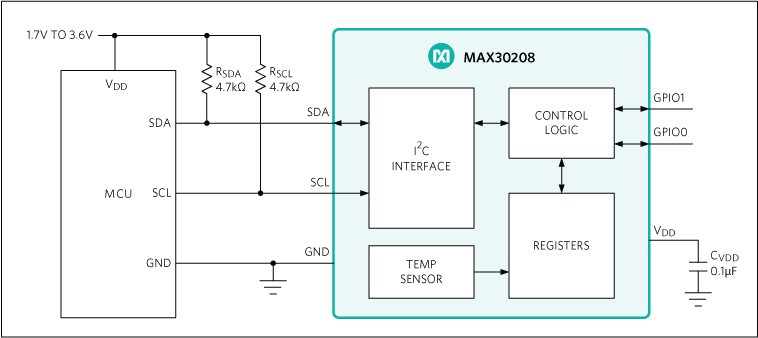
The MAX30208 operates from a 1.7V to 3.6V supply voltage, and is a low-power, high-accuracy digital temperature sensor with ±0.1°C accuracy from +30°C to +50°C and ±0.15°C accuracy from 0°C to +70° C. The MAX30208 has 16-bit resolution (0.005°C).
The device uses a standard I2C serial interface to communicate with a host controller. Two GPIO pins are available. GPIO1 can be configured to trigger a temperature conversion, while GPIO0 can be configured to generate an interrupt for selectable status bits.
The MAX30208 includes a 32-word FIFO for the temperature data and also includes high and low threshold digital temperature alarms. The device is available in a 2mm x 2mm x 0.75mm, 10-pin Thin LGA package.
Applications
- Internet of Things (IoT) Sensors
- Medical Thermometers
- Wearable Body Temperature Monitors
Applications
Consumer Technology Solutions
- Hearable and Wearable Solutions
- Wearable Vital Signs Monitoring Solutions
- Extended Reality (XR) Solution for Edge Devices
Healthcare Solutions
- Activity Tracking and Fall Detection Solutions
- Respiration Rate Measurement Solutions
- Electrocardiogram (ECG) Measurement Solutions
- Wearable Health Monitor Solutions
- Continuous Glucose Monitor (CGM) Solutions
- Diabetes Monitoring and Diagnostic Solutions
- Body Temperature Measurement Solutions
MAX30207
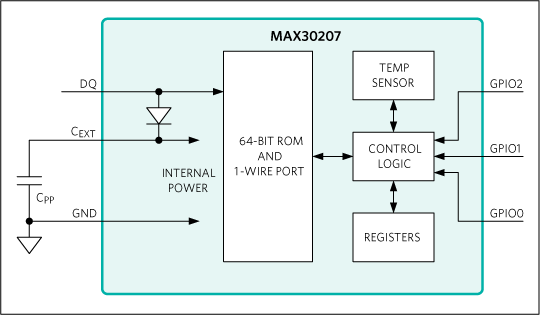
The MAX30207 is a low-power, high-accuracy digital temperature sensor with ±0.1°C accuracy from +30°C to +50°C and ±0.3°C accuracy from 0°C to +70°C. It provides a 16-bit resolution (0.005°C).
The 2mm x 2mm x 0.75mm package design has extremely low thermal mass and can be mounted on a flex PCB with only two conducting traces, allowing for minimal thermal conduction to the system PCB and accurate temperature measurements.
Data is transferred serially through the 1-Wire® protocol, which requires only one data line and a ground reference for communication. Power to the device is also provided using the same data line used for communication using parasite power circuitry inside the device. Each MAX30207 has its own unique 64-bit registration number factory programmed into the chip. This unique 64-bit registration number acts as the node address in a multidrop 1-Wire® network. In multidrop networks, optional GPIO pins may be used as address bits to identify each device's physical location.
Applications
- Internet of Things (IoT) Sensors
- Medical Thermometers
- Wearable Body Temperature Monitors
Applications
Healthcare Solutions
- Activity Tracking and Fall Detection Solutions
- Respiration Rate Measurement Solutions
- Electrocardiogram (ECG) Measurement Solutions
- Wearable Health Monitor Solutions
- Continuous Glucose Monitor (CGM) Solutions
- Diabetes Monitoring and Diagnostic Solutions
- Oxygen Saturation (SpO2) Measurement Solutions
- Body Temperature Measurement Solutions
MAX86178

The MAX86178 is a highly integrated, multiple vital-sign monitoring device with a complete photoplethysmogram (PPG), electrocardiogram (ECG) and biopotential (BioZ) analog front end (AFE) for wearable applications. The MAX86178 offers high performance for wellness and clinical applications with low power for long battery life.
The PPG data acquisition system supports up to 6 LEDs and 4 photodiode inputs. The LEDs are programmable from two high-current, 8-bit LED drivers. The receive path has two low-noise, high-resolution readout channels that each include independent 20-bit ADCs and industry-leading ambient light cancellation (ALC) circuits, producing the highest performing integrated optical data acquisition system on the market today.
The ECG channel has EMI filtering, internal lead biasing, right-leg drive, and extensive calibration voltages for built-in self-test. The ECG channel also has high-input impedance, low noise, high CMRR, programmable gain, an anti-aliasing low-pass filter, and a high-resolution ADC. It is designed to meet IEC 60601-2-47 Ambulatory ECG Systems monitoring compliance requirements.
The BioZ receive channel has EMI filtering and extensive calibration features. The BioZ receive channel also has high input impedance, low noise, programmable gain, low-pass and high-pass filter options, and a high-resolution ADC. There are several modes for generating input stimulus: balanced square-wave source/sink current, sine-wave current, and both sine-wave and square-wave voltage stimuli. A wide range of stimulus magnitudes and frequencies is available.
The MAX86178 has DC and AC lead-off detection, a flexible timing system, and a PLL. All three sensor channels are synchronized. The MAX86178 is available in a 7 x 7 49-bump wafer-level package (WLP) with package dimensions of 2.77mm x 2.57mm, and operates over -40°C to +85°C temperature range.
Applications
- Ambulatory Heart Monitors
- Impedance Cardiography/Hemodynamic Monitors
- Pulse Arrival Time (PAT), Pulse Travel Time (PTT), Pulse Wave Velocity (PWV) Assessments
- Pulse-Oximetry Devices
- Single- and Multi-Frequency Bioimpedance Analysis
- Smart-Clothing Applications
- Wearable Vital-Sign Monitors
Applications
Healthcare Solutions
- Activity Tracking and Fall Detection Solutions
- Respiration Rate Measurement Solutions
- Electrocardiogram (ECG) Measurement Solutions
- Wearable Health Monitor Solutions
- Continuous Glucose Monitor (CGM) Solutions
- Diabetes Monitoring and Diagnostic Solutions
- Body Composition, Hydration, and Bioimpedance Analysis Solutions
- Non-Invasive Blood Pressure (NIBP) Solutions
- Oxygen Saturation (SpO2) Measurement Solutions
Consumer Technology Solutions
- Wearable Vital Signs Monitoring Solutions
- Extended Reality (XR) Solution for Edge Devices
MAX86176

The MAX86176 is a complete photoplethysmogram (PPG) and electrocardiogram (ECG) analog front-end (AFE) solution for wearable applications. The MAX30005 is a complete AFE solution for ECG only. Both AFEs offer high performance for fitness and clinical applications with ultra-low power for long battery life.
Both MAX86176 and MAX30005 feature an ECG channel, EMI filtering, internal-lead biasing, AC and DC lead-off detection, right-leg drive, ultra-low power DC lead-on detection during standby mode, and extensive calibration voltages for built in self-test. In addition, the MAX86176 has a PPG data acquisition system supporting up to 6 LEDs and 4 photodiode inputs, which is fully synchronized with the ECG signal path. The MAX86176/MAX30005 can operate with either internal or external clock. The MAX86176/MAX30005 are designed to meet IEC 60601-2-47 Ambulatory ECG Systems monitoring compliance for even the most challenging dry electrode applications.
The MAX86176/MAX30005 are available in a 6x6 36-bump wafer-level packages (WLP), operating over the -40ºC to +85ºC temperature range.
Applications
- PPG (MAX86176): Wearable Devices for Fitness, Wellness and Medical Applications with Clinical Accuracy
- PPG (MAX86176): Suitable for Wrist, Finger, Ear and Other Locations
- PPG (MAX86176): Optimized Performance to Detect Heart Rate, Oxygen Saturation (SpO2), Muscle and Tissue Oxygen Saturation(SmO2 and StO2), and Body Hydration
- ECG (MAX86176/MAX30005): Single-Lead Event Monitors for Atrial Fibrillation (AFib) and other Arrhythmia Detection
- ECG (MAX86176/MAX30005): Single-Lead Wireless Patches for At-Home/In-Hospital Monitoring
- ECG (MAX86176/MAX30005): Chest-Band Heart-Rate Monitors for Fitness Applications
- ECG (MAX86176/MAX30005): Biometric Authentication and ECG-on-Demand Applications
- PPG-ECG SYNC (MAX86176): Fully Synchronized PPG and ECG Signal Path for PTT Measurements
Applications
Consumer Technology Solutions
- Hearable and Wearable Solutions
Healthcare Solutions
- Activity Tracking and Fall Detection Solutions
- Respiration Rate Measurement Solutions
- Electrocardiogram (ECG) Measurement Solutions
- Wearable Health Monitor Solutions
- Continuous Glucose Monitor (CGM) Solutions
- Diabetes Monitoring and Diagnostic Solutions
- Non-Invasive Blood Pressure (NIBP) Solutions
- Oxygen Saturation (SpO2) Measurement Solutions
MAX86177

The MAX86177 is an ultra-low-power optical data acquisition system with both transmit and receive channels. On the transmitter side, it has two, high-current 8-bit programmable LED drivers and supports up to six LEDs. On the receiver side, it has four low-noise charge integrating front-ends that each includes independent 20-bit analog-to-digital converters (ADCs) and best-in-class ambient light cancellation (ALC) circuits, producing the highest performing integrated optical data acquisition system in the market today.
Due to its low power consumption, compact size, ease and flexibility of use, the MAX86177 is ideal for a wide variety of optical sensing applications such as pulse oximetry and heart rate detection.
The MAX86177 operates on a 1.8V main supply voltage and a 3.1V to 5.5V LED driver supply voltage. The device supports both I2C- and SPI-compatible interfaces in a fully autonomous way. The device has a large 512-word built-in FIFO. The MAX86177 is available in a 7 x 4 28-bump wafer level package (WLP) with dimensions of 2.83mm x 1.89mm, and operates over -40ºC to +85ºC temperature range.
Applications
- Clinical Accuracy
- Optimized Performance to Detect: Optical Heart Rate, Heart Rate Variability, Oxygen Saturation (SpO2), Body Hydration, Muscle and Tissue Oxygen Saturation (SmO2 & StO2), Maximum Oxygen Consumption (VO2 Max)
- Suitable for Wrist, Finger, Ear, and Other Locations
- Wearable Devices for Fitness, Wellness, and Medical Applications
Applications
Consumer Technology Solutions
- Hearable and Wearable Solutions
Healthcare Solutions
- Activity Tracking and Fall Detection Solutions
- Respiration Rate Measurement Solutions
- Electrocardiogram (ECG) Measurement Solutions
- Wearable Health Monitor Solutions
- Non-Invasive Blood Pressure (NIBP) Solutions
- Oxygen Saturation (SpO2) Measurement Solutions
ADPD6000
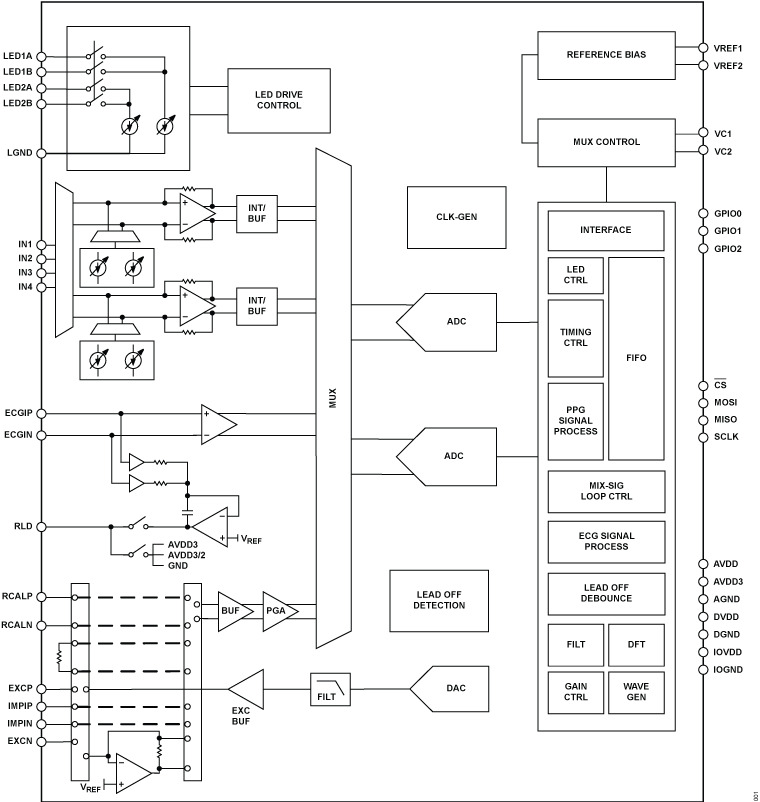
The ADPD6000 is a highly integrated analog front end (AFE) designed for measuring various vital signals.
The optical channel is designed as an optical transceiver, stimulating up to four light emitting diodes (LEDs) and measuring the return signal on up to four separate current inputs. The signal chain rejects signal offsets and corruption from asynchronous modulated interference, typically from ambient light, eliminating the need for optical filters or externally controlled dc cancellation circuitry.
The electrocardiography (ECG) signal acquisition is designed to support low noise, diagnostic level measurement in the presence of a variety of interferers. The ECG signal chain has a number of complementary features supporting ECG measurement, such as driven reference for common-mode rejection and lead off detection to identify a fallen electrode.
The body impedance analysis (BIA) signal chain is designed for body impedance measurement with a configurable excitation path and measurement path. A 12-bit digital-to-analog (DAC) is used in the excitation path to generate the sinusoid wave and high precision measurement, with configurable filters used to measure the body response of the stimulus.
The data output and functional configuration use a serial port interface (SPI) on the ADPD6000. The control circuitry includes flexible LED signaling and synchronous detection, digital filters, digital wave generators, and configurable filters.
The ADPD6000 is available in a 2.6 mm × 2.6 mm, 0.4 mm pitch, 36-ball wafer level chip scale package (WLCSP).
APPLICATIONS
- Wearable health and fitness monitors: heart rate, heart rate variability, SpO2, body impedance analysis, hydration, cuffless noninvasive blood pressure
- Home patient monitoring
- Industrial monitoring: particle and aerosol, gas, and conductivity detection
Applications
Healthcare Solutions
- Non-Invasive Blood Pressure (NIBP) Solutions
- Wearable Health Monitor Solutions
- Oxygen Saturation (SpO2) Measurement Solutions
- Electrocardiogram (ECG) Measurement Solutions
- Respiration Rate Measurement Solutions
MAX32665
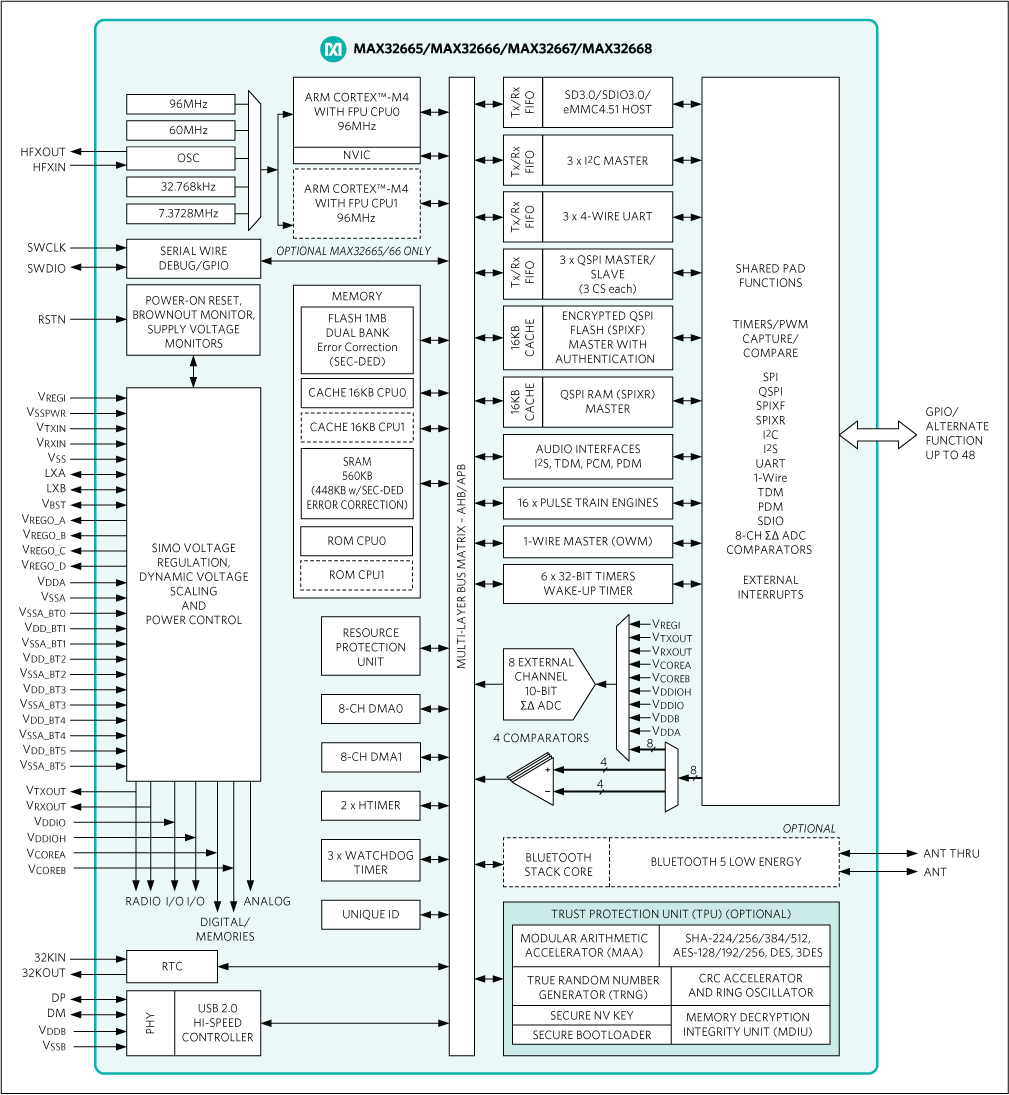
DARWIN is a new breed of low-power microcontrollers built to thrive in the rapidly evolving Internet of Things (IoT). They are smart, with the biggest memories in their class and a massively scalable memory architecture. They run forever, thanks to wearable-grade power technology. They are durable enough to withstand the most advanced cyberattacks. DARWIN microcontrollers are designed to run any application imaginable—in places where you would not dream of sending other microcontrollers.
Generation UB microcontrollers are designed to handle the increasingly complex applications demanded by today's advanced battery-powered devices and wirelessly connected devices, while providing robust hardware security and Bluetooth® 5 Low Energy (Bluetooth LE) radio connectivity.
The MAX32665/MAX32666 UB class microcontrollers are advanced systems-on-chips featuring an Arm® Cortex®-M4 with FPU CPU for efficient computation of complex functions and algorithms with integrated power management. They also include the newest generation Bluetooth 5 LE radio with high throughput (2Mbps) and ADI's best-in-class hardware security suite trust protection unit (TPU). The devices offer large on-board memory with 1MB flash and 560KB SPAM. Split flash banks of 512KB each support seamless over-the-air upgrades, adding an additional degree of reliability. Memory scalability of data (SRAM) and code (flash) space is supported by two SPI execute-in-place (SPIX) interfaces.
Multiple high-speed interfaces are supported including HS-USB, secure digital interface (SD, SDIO, MMC, SDHC, and microSD™), SPI, UART, and I2C serial interfaces, and an audio subsystem supporting PDM, PCM, I2S, and TDM interfaces. An 8-input, 10-bit ADC is available to monitor analog inputs from external sensors and meters. The devices are available in 109-bump WLP (0.35mm pitch) and 121-bump CTBGA (0.65mm pitch).
Applications
- Connected Home
- Gaming Devices
- Hearables
- Industrial Sensors
- Payment/Fitness/Medical Wearables
- Telemedicine
Applications
Consumer Technology Solutions
- Personal Electronics Solutions
- Low Power and High Security Solutions for Personal Electronics
MAX32670
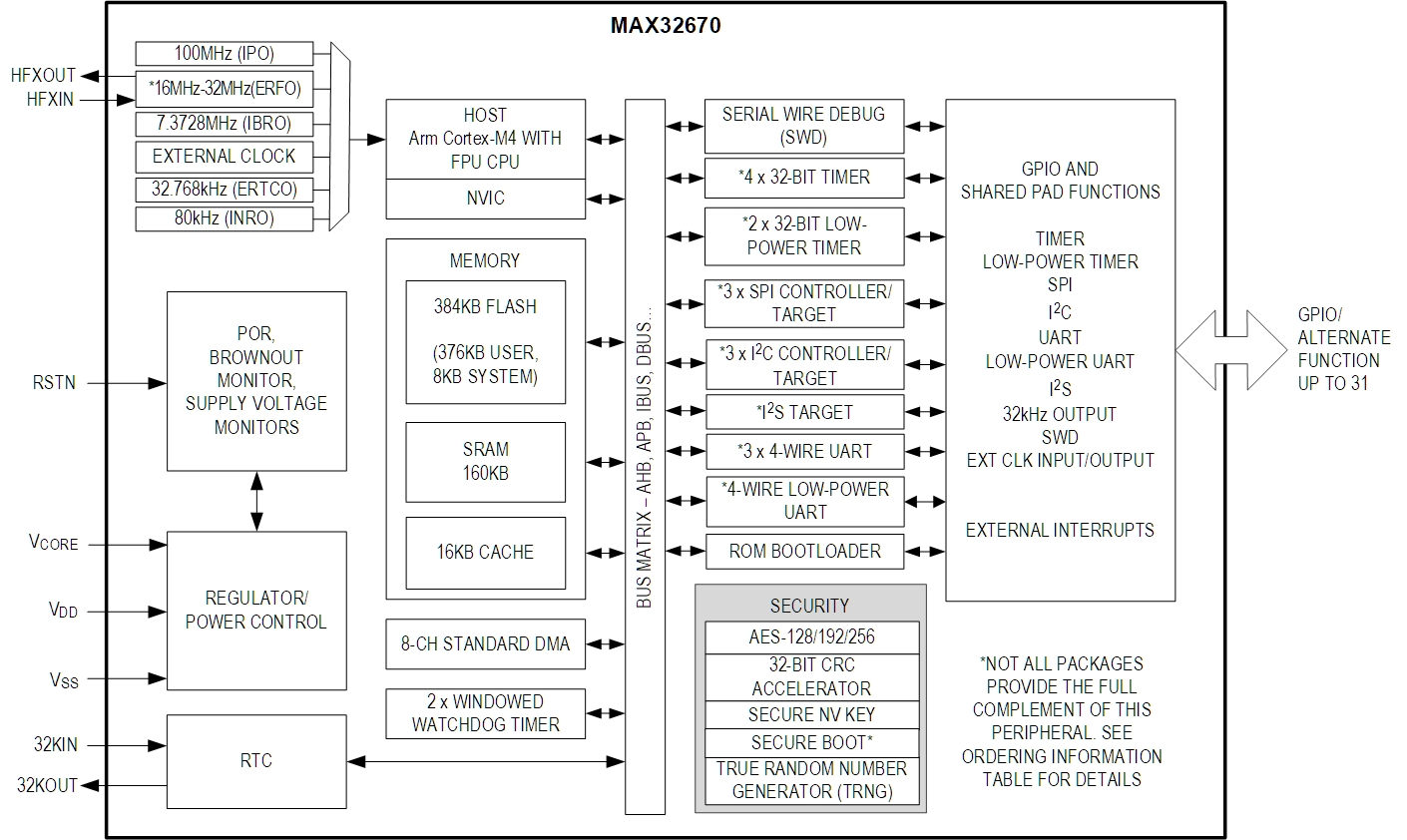
In the Darwin family, the MAX32670 is an ultra-low-power, cost-effective, high-reliability 32-bit microcontroller enabling designs with complex sensor processing without compromising battery life. It combines a flexible and versatile power management unit with the powerful Arm® Cortex®-M4 processor with a floating point unit (FPU). It also offers legacy designs an easy and cost-optimal upgrade path from 8- or 16-bit microcontrollers.
The device integrates 384KB (376KB user) of flash memory and 160KB of SRAM to accommodate application and sensor code. Additional features, such as the two windowed watchdog timers with fully flexible and independent clocking, have been added to further enhance reliable operation. Brown-out detection ensures proper operation during power-down/power-up events and unexpected supply transients.
Multiple high-speed peripherals such as 3.4MHz I2C, 50MHz SPI, and UARTs maximize communication bandwidth. In addition, a low-power UART is available for operation in the lowest-power sleep modes to facilitate wake-up on activity without any loss of data. A total of six timers with I/O capability are provided, including two low-power timers to enable pulse counting, capture/compare, and PWM generation in the lowest-power sleep modes. All of this capability is packaged in a tiny form factor: 5mm × 5mm, 40-pin TQFN-EP or 1.75mm × 2.50mm, 24-bump WLP.
Applications
- Smart Sensor Controller
- Industrial Sensors
- Optical Communication Modules
- Secure Radio Modem Controller
- Battery-Powered Medical Devices
- System Housekeeping Controller
- Algorithm Coprocessor
Applications
Energy Solutions
- Smart Meter Technology
Healthcare Solutions
- Therapy Device Solutions for Healthcare
- Activity Tracking and Fall Detection Solutions
- Respiration Rate Measurement Solutions
- Electrocardiogram (ECG) Measurement Solutions
- Wearable Health Monitor Solutions
- Oxygen Saturation (SpO2) Measurement Solutions
Intelligent Building Solutions
- Smoke Detection Systems
- Surveillance Camera Solutions
- Building Automation Controllers and Network Solutions
Industrial Automation
- Smart Factory IO - Link Sensor Actuator Solutions
- Smart Factory IO - Link Master Solutions
ADPD4100
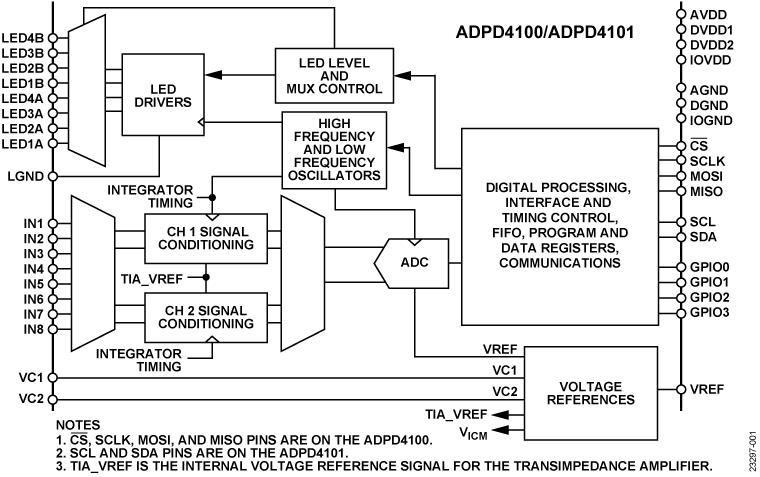
The ADPD4100/ADPD4101 operate as a complete multimodal sensor front end, stimulating up to eight light emitting diodes (LEDs) and measuring the return signal on up to eight separate current inputs. Twelve time slots are available, enabling 12 separate measurements per sampling period.
The data output and functional configuration utilize an I2C interface on the ADPD4101 or a serial port interface (SPI) on the ADPD4100. The control circuitry includes flexible LED signaling and synchronous detection. The devices use a 1.8 V analog core and 1.8 V/3.3 V compatible digital input/output (I/O).
The analog front end (AFE) rejects signal offsets and corruption from asynchronous modulated interference, typically from ambient light, eliminating the need for optical filters or externally controlled dc cancellation circuitry. Multiple operating modes are provided, enabling the ADPD4100/ADPD4101 to be a sensor hub for synchronous measurements of photodiodes, biopotential electrodes, resistance, capacitance, and temperature sensors. The multiple operation modes accommodate various sensor measurements, including, but not limited to, photoplethysmography (PPG), electrocardiography (ECG), electrodermal activity (EDA), impedance, capacitance, temperature, gas detection, smoke detection, and aerosol detection for various healthcare, industrial, and consumer applications.
The ADPD4100/ADPD4101 are available in a 3.11 mm × 2.14 mm, 0.4 mm pitch, 33-ball WLCSP and 35-ball WLCSP
Applications
- Wearable health and fitness monitors: heart rate monitors (HRMs), heart rate variability (HRV), stress, blood pressure estimation, SpO2, hydration, body composition
- Industrial monitoring: CO, CO2, smoke, and aerosol detection
- Home patient monitoring
Applications
Healthcare Solutions
- Activity Tracking and Fall Detection Solutions
- Respiration Rate Measurement Solutions
- Electrocardiogram (ECG) Measurement Solutions
- Wearable Health Monitor Solutions
- Oxygen Saturation (SpO2) Measurement Solutions
- Point of Care (PoC) Diagnostic Solutions
- Non-Invasive Blood Pressure (NIBP) Solutions
Consumer Technology Solutions
- Hearable and Wearable Solutions
ADPD4101

The ADPD4100/ADPD4101 operate as a complete multimodal sensor front end, stimulating up to eight light emitting diodes (LEDs) and measuring the return signal on up to eight separate current inputs. Twelve time slots are available, enabling 12 separate measurements per sampling period.
The data output and functional configuration utilize an I2C interface on the ADPD4101 or a serial port interface (SPI) on the ADPD4100. The control circuitry includes flexible LED signaling and synchronous detection. The devices use a 1.8 V analog core and 1.8 V/3.3 V compatible digital input/output (I/O).
The analog front end (AFE) rejects signal offsets and corruption from asynchronous modulated interference, typically from ambient light, eliminating the need for optical filters or externally controlled dc cancellation circuitry. Multiple operating modes are provided, enabling the ADPD4100/ADPD4101 to be a sensor hub for synchronous measurements of photodiodes, biopotential electrodes, resistance, capacitance, and temperature sensors. The multiple operation modes accommodate various sensor measurements, including, but not limited to, photoplethysmography (PPG), electrocardiography (ECG), electrodermal activity (EDA), impedance, capacitance, temperature, gas detection, smoke detection, and aerosol detection for various healthcare, industrial, and consumer applications.
The ADPD4100/ADPD4101 are available in a 3.11 mm × 2.14 mm, 0.4 mm pitch, 33-ball WLCSP and 35-ball WLCSP
Applications
- Wearable health and fitness monitors: heart rate monitors (HRMs), heart rate variability (HRV), stress, blood pressure estimation, SpO2, hydration, body composition
- Industrial monitoring: CO, CO2, smoke, and aerosol detection
- Home patient monitoring
Applications
Healthcare Solutions
- Point of Care (PoC) Diagnostic Solutions
- Non-Invasive Blood Pressure (NIBP) Solutions
- Wearable Health Monitor Solutions
- Oxygen Saturation (SpO2) Measurement Solutions
- Electrocardiogram (ECG) Measurement Solutions
Instrumentation and Measurement Solutions
- Water and Air Quality Monitoring Solutions
AD8233

The AD8233 is an integrated signal conditioning block for electrocardiogram (ECG) and other biopotential measurement applications. It is designed to extract, amplify, and filter small biopotential signals in the presence of noisy conditions, such as those created by motion or remote electrode placement. This design allows an ultralow power analog-to-digital converter (ADC) or an embedded microcontroller to easily acquire the output signal.
The AD8233 implements a two-pole, high-pass filter for eliminating motion artifacts and the electrode half cell potential. This filter is tightly coupled with the instrumentation amplifier architecture to allow both large gain and high-pass filtering in a single stage, thereby saving space and cost.
An uncommitted operational amplifier enables the AD8233 to create a three-pole, low-pass filter to remove additional noise. The user can select the frequency cutoff of all filters to suit different types of applications.
To improve the common-mode rejection of the line frequencies in the system and other undesired interferences, the AD8233 includes a right leg drive (RLD) amplifier for driven electrode applications.
The AD8233 includes a fast restore function that reduces the duration of the otherwise long settling tails of the high-pass filters. After an abrupt signal change that rails the amplifier (such as a leads off condition), the AD8233 automatically adjusts to a higher filter cutoff. This feature allows the AD8233 to recover quickly, and therefore, to take valid measurements soon after connecting the electrodes to the subject.
The AD8233 is available in a 2 mm × 1.7 mm, 20-ball WLCSP package and a 150 μm thin die for height constrained applications. Performance is specified from 0°C to 70°C and is operational from −40°C to +85°C.
APPLICATIONS
- Fitness and activity heart rate monitors
- Portable ECG
- Wearable and remote health monitors
- Gaming peripherals
- Biopotential signal acquisition, such as EMG or EEG
Applications
Healthcare Solutions
- Activity Tracking and Fall Detection Solutions
- Respiration Rate Measurement Solutions
- Therapy Device Solutions for Healthcare
- Vital Signs Monitoring Solutions
- Electrocardiogram (ECG) Measurement Solutions
- Non-Invasive Blood Pressure (NIBP) Solutions
- Wearable Health Monitor Solutions
Industrial Automation
- Programmable Logic Controllers (PLC) and Distributed Control Systems (DCS)
- Field Instrument Systems
Consumer Technology Solutions
- Extended Reality (XR) Solution for Edge Devices
Precision Technology Solutions
- Precision Low Power Solutions
ADF7030

The ADF7030 is a low power, high performance, integrated radio transceiver supporting narrowband operation in the 169.4MHz to 169.6MHz ISM bands. The ADF7030 supports transmit and receive operation at 2.4kbps and 4.8kbps using 2GFSK modulation and transmit operation at 6.4kbps using 4GFSK modulation.
The ADF7030 features an on-chip ARM® Cortex®-M0 processor that performs radio control and packet management.
Applications- Wireless M-Bus Mode N (EN 13757-4)
- Smart metering
- Social alarms
- Active tag asset tracking
Applications
Aerospace and Defense Systems
- Military Communication Solutions
- Avionic Systems
Industrial Automation
- Field Instrument Systems
Healthcare Solutions
- Vital Signs Monitoring Solutions
- Electrocardiogram (ECG) Measurement Solutions
- Therapy Device Solutions for Healthcare
- Wearable Health Monitor Solutions
ADP5301
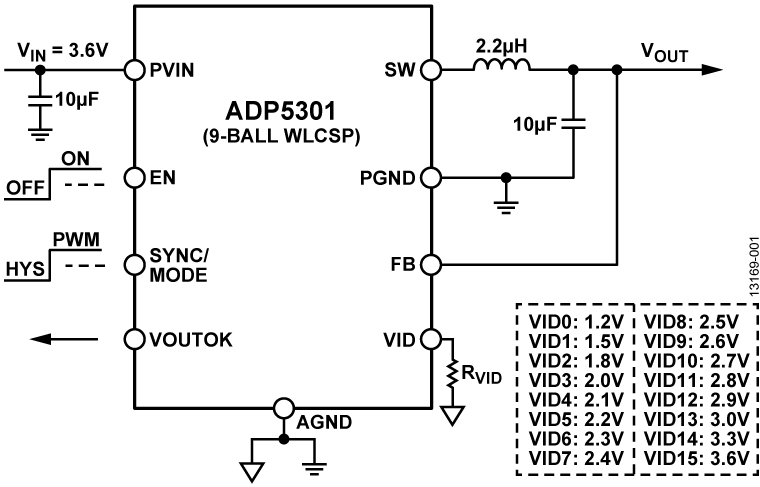
The ADP5301 is a high efficiency, ultralow quiescent current step-down regulator that draws only a 180 nA quiescent current to regulate the output at no load.
The ADP5301 runs from an input startup voltage range of 2.15 V to 6.50 V, allowing the use of multiple alkaline/NiMH, Li-Ion cells, or other power sources. The output voltage is selectable from 0.8 V to 5.0 V by an external VID resistor and factory fuse. The total solution requires only four tiny external components.
The ADP5301 can operate between hysteresis mode and PWM mode via the SYNC/MODE pin. The regulator in hysteresis mode achieves excellent efficiency at a power of less than 1 mW and provides up to 50 mA of output current. The regulator in PWM mode produces a lower output ripple and supplies up to 500 mA of output current. The flexible configuration capability during operation of the device enables very efficient power management to meet both the longest battery life and low system noise requirements.
The ADP5301 contains a VOUTOK flag, which monitors the output voltage and runs at a 2 MHz switching frequency in PWM mode. SYNC/MODE can synchronize to an external clock from 1.5 MHz to 2.5 MHz.
Other key features in the ADP5301 include separate enabling, quick output discharge (QOD), and safety features such as overcurrent protection (OCP), thermal shutdown (TSD), and input undervoltage lockout (UVLO).
The ADP5301 is available in a 9-ball, 1.65 mm × 1.87 mm WLCSP rated for a −40°C to +125°C junction temperature range.
Applications
- Energy (gas and water) metering
- Portable and battery-powered equipment
- Medical applications
- Keep-alive power supplies
Applications
Intelligent Building Solutions
- Surveillance Camera Solutions
Consumer Technology Solutions
- Hearable and Wearable Solutions
Healthcare Solutions
- Vital Signs Monitoring Solutions
- Electrocardiogram (ECG) Measurement Solutions
- Electroencephalogram (EEG) Measurement Solutions
- Non-Invasive Blood Pressure (NIBP) Solutions
- Respiration Rate Measurement Solutions
- Oxygen Saturation (SpO2) Measurement Solutions
- Body Composition, Hydration, and Bioimpedance Analysis Solutions
- Insulin Pump Solutions
- Activity Tracking and Fall Detection Solutions
- Wearable Health Monitor Solutions
ADPD107
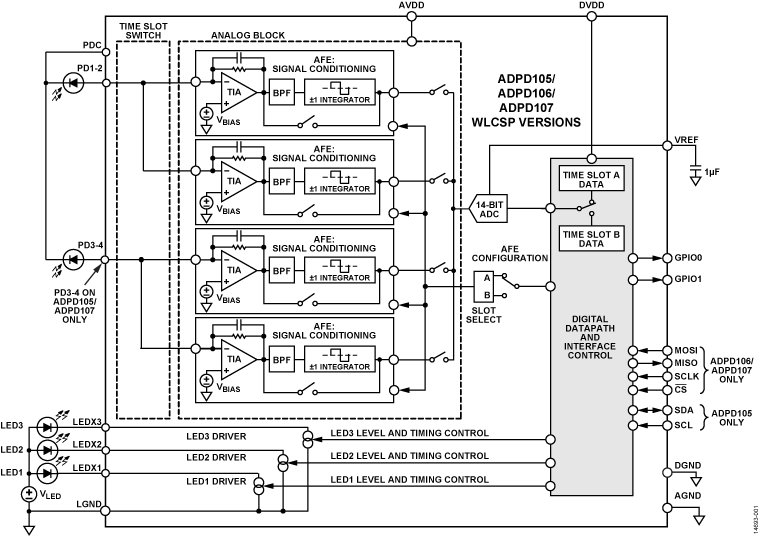
The ADPD105/ADPD106/ADPD107 are highly efficient, photometric front ends, each with an integrated 14-bit analog-to-digital converter (ADC) and a 20-bit burst accumulator that works with flexible light emitting diode (LED) drivers. The accumulator is designed to stimulate an LED and measure the corresponding optical return signal. The data output and functional configuration occur over a 1.8 V I2C interface on the ADPD105 or SPI on the ADPD106 and ADPD107. The control circuitry includes flexible LED signaling and synchronous detection.
The analog front end (AFE) features best-in-class rejection of signal offset and corruption due to modulated interference commonly caused by ambient light.
Couple the ADPD105/ADPD106/ADPD107 with a low capacitance photodiode of <100 pF for optimal performance. The ADPD105/ADPD106/ADPD107 can be used with any LED. The ADPD105 is available in a 2.46 mm × 1.4 mm WLCSP and a 4 mm × 4 mm LFCSP. The SPI only versions, ADPD106 and ADPD107, are available in a 2.46 mm × 1.4 mm WLCSP.
Applications
- Wearable health and fitness monitors
- Clinical measurements, for example, SpO2
- Industrial monitoring
- Background light measurements
Applications
Healthcare Solutions
- Vital Signs Monitoring Solutions
- Non-Invasive Blood Pressure (NIBP) Solutions
- Oxygen Saturation (SpO2) Measurement Solutions
- Wearable Health Monitor Solutions
ADuCM3029
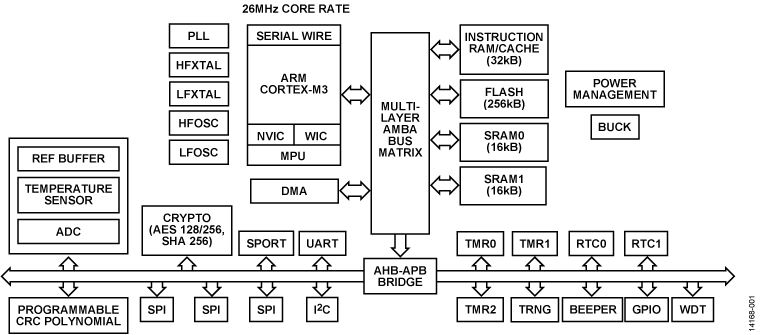
The ADuCM3027/ADuCM3029 microcontroller units (MCUs) are ultra low power microcontroller systems with integrated power management for processing, control, and connectivity. The MCU system is based on the ARM® Cortex®-M3 processor, a collection of digital peripherals, embedded SRAM and flash memory, and an analog subsystem which provides clocking, reset, and power management capability in addition to an analog-to-digital converter (ADC) subsystem. For a feature comparison across the ADuCM3027/ADuCM3029 product offerings, see Table 1.
| Device | Embedded Flash Memory Size |
| ADuCM3029 | 256 kB |
| ADuCM3027 | 128 kB |
System features that are common across the ADuCM3027/ADuCM3029/ADuCM3029-1/ADuCM3029-2 MCUs include the following:
- Up to 26 MHz ARM Cortex-M3 processor
- Up to 256 kB of embedded flash memory with error correction code (ECC)
- Optional 4 kB cache for lower active power
- 64 kB system SRAM with parity
- Power management unit (PMU)
- Multilayer advanced microcontroller bus architecture (AMBA) bus matrix
- Central direct memory access (DMA) controller
- Beeper interface
- Serial port (SPORT), serial peripheral interface (SPI), inter-integrated circuit (I2C), and universal asynchronous receiver/transmitter (UART) peripheral interfaces
- Cryptographic hardware support with advanced encryption standard (AES) and secure hash algorithm (SHA)-256
- Real-time clock (RTC)
- General-purpose and watchdog timers
- Programmable general-purpose input/output (GPIO) pins
- Hardware cyclic redundancy check (CRC) calculator with programmable generator polynomial
- Power-on reset (POR) and power supply monitor (PSM)
- 12-bit successive approximation register (SAR) ADC
- True random number generator (TRNG)
To support low dynamic and hibernate power management, the ADuCM3027/ADuCM3029 MCUs provide a collection of power modes and features, such as dynamic and software controlled clock gating and power gating.
The ADuCM3029-1 and ADuCM3029-2 MCU models share the same features and functionality as that of the ADuCM3029 MCU. All specifications pertaining to the ADuCM3027 and ADuCM3029 are also applicable to the ADuCM3029-1 and ADuCM3029-2.
For full details on the ADuCM3027/ADuCM3029 MCUs, refer to the ADuCM302x Ultra Low Power ARM Cortex-M3 MCU with Integrated Power Management Hardware Reference Manual.
Product Highlights
- Industry leading ultralow power consumption.
- Robust operation, including full voltage monitoring in deep sleep modes, ECC support on flash, and parity error detection on SRAM memory.
- Leading edge security. Fast encryption provides read protection to customer algorithms. Write protection prevents device reprogramming by unauthorized code.
- Failure detection of 32 kHz LFXTAL via interrupt.
- SensorStrobe™ for precise time synchronized sampling of external sensors. Works in hibernate mode, resulting in drastic current reduction in system solutions. Current consumption reduces by 10 times when using, for example, the ADXL363 accelerometer. Software intervention is not required after setup. No pulse drift due to software execution.
Applications
- Internet of Things (IoT)
- Electronic shelf label (ESL) and signage
- Smart infrastructure
- Smart lock
- Asset tracking
- Smart machine, smart metering, smart building, smart city, and smart agriculture
- Wearables
- Fitness and clinical
- Machine learning and neural network
Applications
Intelligent Building Solutions
- Environmental Building Monitoring Solutions
- Building Automation Controllers and Network Solutions
- Building Fire Safety and Surveillance Solutions
- Smoke Detection Systems
Healthcare Solutions
- Point of Care (PoC) Diagnostic Solutions
- Vital Signs Monitoring Solutions
- Electrocardiogram (ECG) Measurement Solutions
- Electroencephalogram (EEG) Measurement Solutions
- Non-Invasive Blood Pressure (NIBP) Solutions
- Respiration Rate Measurement Solutions
- Oxygen Saturation (SpO2) Measurement Solutions
- Body Composition, Hydration, and Bioimpedance Analysis Solutions
- Insulin Pump Solutions
- Activity Tracking and Fall Detection Solutions
- Wearable Health Monitor Solutions
Aerospace and Defense Systems
- Military Communication Solutions
Instrumentation and Measurement Solutions
- Communications Test Equipment Solutions
- Signal Generator (Audio through RF) Solutions
- Radio Frequency (RF) Signal and Vector Network Analyzer Solutions
- DC Sources and Power Supply Solutions
- Parametric Measurement Solutions
- Precision Measurement Solutions
Industrial Automation
- Predictive Maintenance Solutions
- Field Instrument Systems
ADXL354
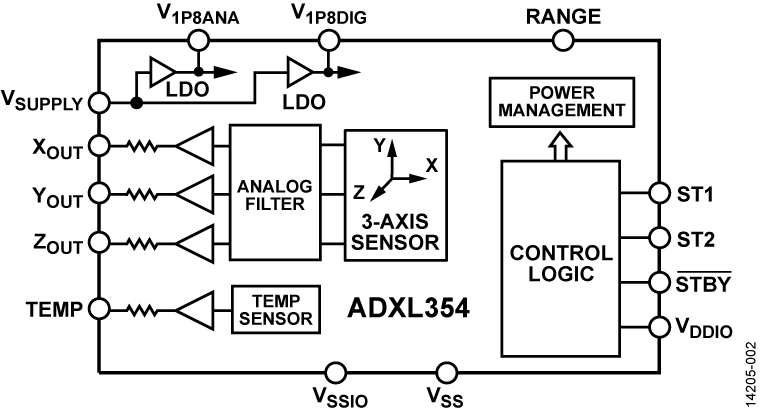
The analog output ADXL354 and the digital output ADXL355 are low noise density, low 0 g offset drift, low power, 3-axis accelerometers with selectable measurement ranges. The ADXL354B supports the ±2 g and ±4 g ranges, the ADXL354C supports the ±2 g and ±8 g ranges, and the ADXL355 supports the ±2 g, ±4 g, and ±8 g ranges. The ADXL354/ADXL355 offer industry leading noise, minimal offset drift over temperature, and long-term stability enabling precision applications with minimal calibration.
Highly integrated in a compact form factor, the low power ADXL355 is ideal in an Internet of Things (IoT) sensor node and other wireless product designs.
The ADXL355 multifunction pin names may be referenced by their relevant function only for either the serial peripheral interface (SPI) or I2C interface.
Applications
- Inertial measurement units (IMUs)/altitude and heading reference systems (AHRS)
- Platform stabilization systems
- Structural health monitoring
- Seismic imaging
- Tilt sensing
- Robotics
- Condition Monitoring
Applications
Energy Solutions
- Wind Turbine Solutions
- Energy Storage Solutions
Industrial Automation
Healthcare Solutions
- Vital Signs Monitoring Solutions
- Wearable Health Monitor Solutions
Aerospace and Defense Systems
- Missiles and Precision Munitions
- Unmanned Aerial Vehicles (UAV)
- Avionic Systems
Sensor Interface Solutions
- Vibration Sensing Solutions
ADXL355
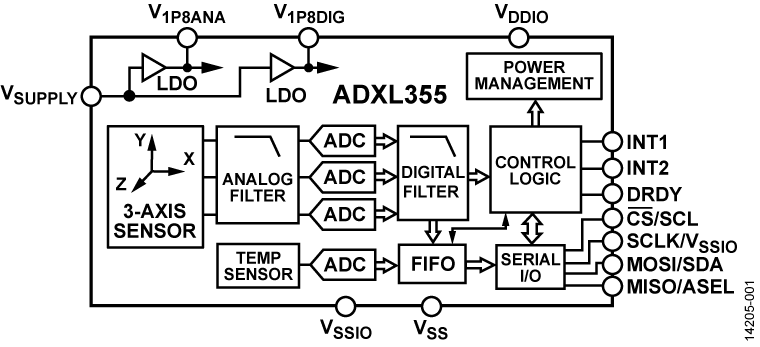
The analog output ADXL354 and the digital output ADXL355 are low noise density, low 0 g offset drift, low power, 3-axis accelerometers with selectable measurement ranges. The ADXL354B supports the ±2 g and ±4 g ranges, the ADXL354C supports the ±2 g and ±8 g ranges, and the ADXL355 supports the ±2 g, ±4 g, and ±8 g ranges. The ADXL354/ADXL355 offer industry leading noise, minimal offset drift over temperature, and long-term stability enabling precision applications with minimal calibration.
Highly integrated in a compact form factor, the low power ADXL355 is ideal in an Internet of Things (IoT) sensor node and other wireless product designs.
The ADXL355 multifunction pin names may be referenced by their relevant function only for either the serial peripheral interface (SPI) or I2C interface.
Applications
- Inertial measurement units (IMUs)/altitude and heading reference systems (AHRS)
- Platform stabilization systems
- Structural health monitoring
- Seismic imaging
- Tilt sensing
- Robotics
- Condition Monitoring
Applications
Intelligent Building Solutions
- Surveillance Camera Solutions
Energy Solutions
- Wind Turbine Solutions
- Energy Storage Solutions
Industrial Automation
Healthcare Solutions
- Vital Signs Monitoring Solutions
- Wearable Health Monitor Solutions
- Non-Invasive Blood Pressure (NIBP) Solutions
Aerospace and Defense Systems
- Missiles and Precision Munitions
- Unmanned Aerial Vehicles (UAV)
- Avionic Systems
Sensor Interface Solutions
- Vibration Sensing Solutions
ADXL362
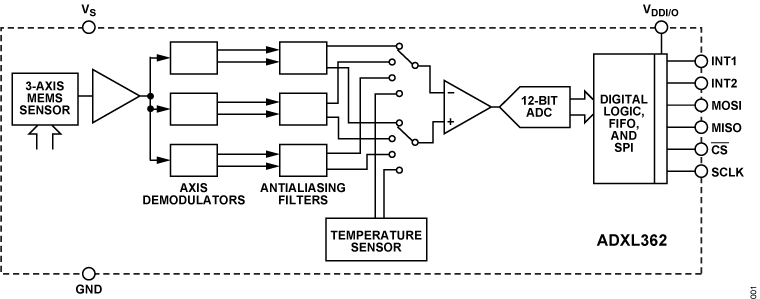
The ADXL362 is an ultralow power, 3-axis MEMS accelerometer that consumes less than 2 μA at a 100 Hz output data rate and 270 nA when in motion triggered wake-up mode. Unlike accelerometers that use power duty cycling to achieve low power consumption, the ADXL362 does not alias input signals by undersampling; it samples the full bandwidth of the sensor at all data rates.
The ADXL362 always provides 12-bit output resolution; 8-bit formatted data is also provided for more efficient single-byte transfers when a lower resolution is sufficient. Measurement ranges of ±2 g, ±4 g, and ±8 g are available, with a resolution of 1 mg/LSB on the ±2 g range. For applications where a noise level lower than the normal 550 μg/√Hz of the ADXL362 is desired, either of two lower noise modes (down to 175 μg/√Hz typical) can be selected at minimal increase in supply current.
In addition to its ultralow power consumption, the ADXL362 has many features to enable true system level power reduction. It includes a deep multimode output FIFO, a built-in micropower temperature sensor, and several activity detection modes including adjustable threshold sleep and wake-up operation that can run as low as 270 nA at a 6 Hz (approximate) measurement rate. A pin output is provided to directly control an external switch when activity is detected, if desired. In addition, the ADXL362 has provisions for external control of sampling time and/or an external clock.
The ADXL362 operates on a wide 1.6 V to 3.5 V supply range, and can interface, if necessary, to a host operating on a separate, lower supply voltage. The ADXL362 is available in a 3 mm × 3.25 mm × 1.06 mm package.
APPLICATIONS
- Hearing aids
- Home healthcare devices
- Motion enabled power save switches
- Wireless sensors
- Motion enabled metering devices
Applications
Healthcare Solutions
- Therapy Device Solutions for Healthcare
- In Vitro Diagnostic Solutions
- Body Temperature Measurement Solutions
- Insulin Pump Solutions
- Non-Invasive Blood Pressure (NIBP) Solutions
- Electrocardiogram (ECG) Measurement Solutions
- Vital Signs Monitoring Solutions
- Activity Tracking and Fall Detection Solutions
- Wearable Health Monitor Solutions
Intelligent Building Solutions
- Building Fire Safety and Surveillance Solutions
Aerospace and Defense Systems
- Avionic Systems
- Missiles and Precision Munitions
- Unmanned Aerial Vehicles (UAV)
Signal Chains
(6)
Interactive Signal Chains


Evaluation Boards
MAX86173EVSYS
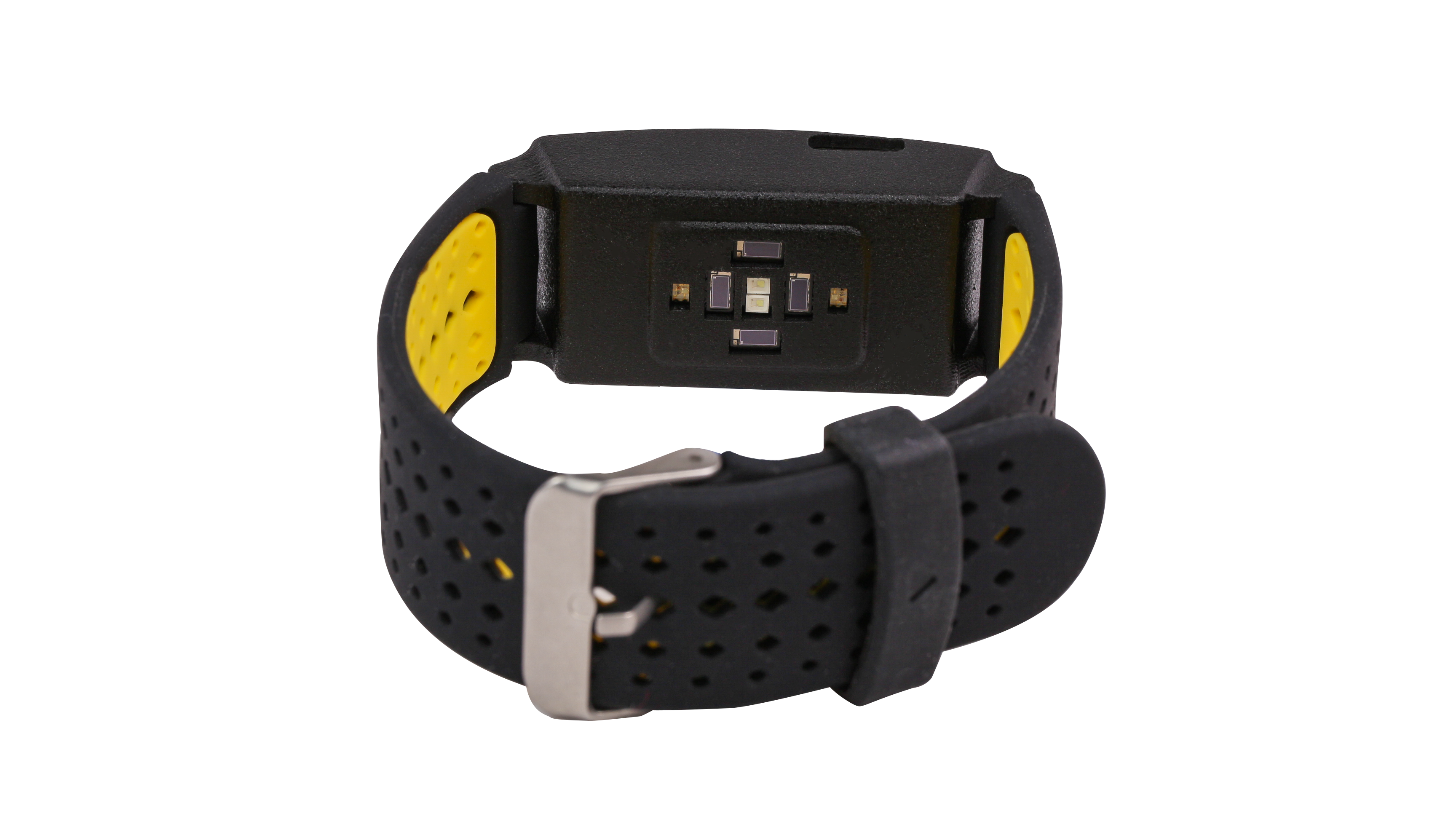
The MAX86173 evaluation system (EV Sys) allows for the quick evaluation of the MAX86173 optical AFE for applications at various sites on the body, particularly the wrist. MAX86173 supports both I2C and SPI compatible interfaces. MAX86173 has two optical readout channels that operate simultaneously. The EV Sys allows flexible configurations to optimize measurement signal quality at minimal power consumption. The EV Sys supports file logging and flash logging, allowing the user to disconnect from the computer for more convenient data capturing sessions, such as overnight or outdoor running.
The EV Sys consists of two boards. MAXSENSORBLE_ EVKIT_B is the main data acquisition board while MAX86173_OSB_EVKIT_B is the sensor daughter board for MAX86173. To enable PPG measurement capabilities, the sensor board contains eight LEDs (OSRAM CT DBLP31.12, green LED, and OSRAM SFH7013, red, green, and IR 3-in-1 LED package) and four discrete photodiodes (Vishay VEMD8080), and an accelerometer. The EV Sys is powered through a LiPo Battery attached inside it and can be charged using a Type-C port. The EV Sys communicates with the MAX86173GUI (should be installed in the user’s system) using Bluetooth® built into Windows (Win BLE). The EV Sys contains the latest firmware but comes with the programming circuit board MAXDAP-TYPE-C in case a firmware upgrade is needed.
Applications
- Wearable Devices for Fitness, Wellness and Medical Applications
- Clinical Accuracy
- Suitable for Wrist, Finger, Ear and Other Locations
- Optimized Performance to Detect:
- Optical Heart Rate
- Heart-Rate Variability
- Oxygen Saturation (SpO2)
- Body Hydration
- Muscle and Tissue Oxygen Saturation (SmO2 and StO2)
- Maximum Oxygen Consumption (VO2 max)
Applicable Parts
MAX86173
Dual-Channel Optical AFE with High Signal-to-Noise Ratio for Wearable Health
Applications
Healthcare Solutions
- Activity Tracking and Fall Detection Solutions
- Respiration Rate Measurement Solutions
- Electrocardiogram (ECG) Measurement Solutions
- Wearable Health Monitor Solutions
MAX86177EVSYS

The MAX86177 evaluation system (EV system) allows for the quick evaluation of the MAX86177 optical AFE for applications at various sites on the body, particularly the wrist. The EV sys supports both I2C and SPI compatible interfaces. The EV sys has four optical readout channels that operate simultaneously. The EV sys allows flexible configurations to optimize measurement signal quality at minimal power consumption. The EV sys supports file logging and flash logging, allowing the user to disconnect from the computer for more convenient data capturing sessions, such as overnight or outdoor running.
The EV sys consists of two boards. MAXSENSORBLE_ EVKIT_B is the main data acquisition board while MAX86177_OSB_EVKIT_A is the sensor daughter board for the MAX86177. To enable PPG measurement capabilities, the sensor board contains six LEDs (two OSRAM SFH7016, red, green, and IR 3-in-1 LED package) and eight discrete photodiodes (OSRAM SFH2704), and an accelerometer. The EV sys is powered through a LiPo battery attached inside it and can be charged using a Type-C port. The EV Sys communicates with MAX86177GUI (should be installed in user’s system) using Bluetooth® built into Windows (Win BLE). The EV sys contains the latest firmware but comes with the programming circuit board MAXDAP-TYPE-C in case a firmware upgrade is needed.
Applications
- Optical Heart Rate
- Optimized performance for high SNR PPG signal to detect
- Oxygen Saturation (SpO2)
- Suitable for Wrist, Finger, Ear, Chest, and Abdomen
- Wearable Devices for Fitness, Wellness & Medical Applications
Applicable Parts
MAX86177
Quad-Channel AFE for Low-Power Heart Rate Monitor and Pulse Oximeter
Applications
Consumer Technology Solutions
- Hearable and Wearable Solutions
Healthcare Solutions
- Activity Tracking and Fall Detection Solutions
- Respiration Rate Measurement Solutions
- Electrocardiogram (ECG) Measurement Solutions
- Wearable Health Monitor Solutions
- Non-Invasive Blood Pressure (NIBP) Solutions
- Oxygen Saturation (SpO2) Measurement Solutions
- Body Temperature Measurement Solutions
MAX30009EVKIT

The MAX30009EVKIT# evaluation kit (EV kit) provides a platform to evaluate the functionality and features of the MAX30009 Low-Power, High-Performance Bioimpedance (BioZ) Analog Front End. The EV kit allows for flexible hardware and software configurations to help the user quickly learn how to configure and optimize the MAX30009 for their applications.
The MAX30009 is a complete Bioimpedance (BioZ) analog front-end solution for wearable applications. It offers high performance for fitness, wellness, and clinical applications and ultra-low power for long battery life. The BioZ receive channel has ESD protection, EMI filtering, internal lead biasing, DC leads off detection, DRVN lead-off detection, and ultra-low power lead-on detection during standby mode. The BioZ receive channel also has high input impedance, low noise, high CMRR, programmable gain, various low-pass, and high-pass filter options, and two high-resolution analog to digital converters for simultaneous I and Q acquisition.
The MAX30009EVKIT# EV kit consists of two boards. MAXSENSORBLE_EVKIT_B is the microcontroller (MCU) board while MAX30009_EVKIT_B is the sensor board containing the MAX30009. The EV kit is powered by a LiPo battery, which is recharged through a USB-C cable. The EV Sys communicates with MAX30009GUI (should be installed in the user system) via Bluetooth® (WIN BLE).The EV kit contains the latest firmware but comes with the programming circuit board MAXDAP-TYPE-C in case a firmware change is needed.
Applications
- Wearable Fitness, Wellness, and Medical Devices
- Multifrequency Body Composition Analyzers
- Non-Invasive Hemodynamic Monitors
- Automatic External Defibrillators
- Optimized Performance to Accurately Detect:
- Respiration Rate
- Galvanic Skin Response/Electrodermal Activity
- Bioimpedance Spectroscopy
- Body Composition and Fluid Analysis
- Impedance Cardiography and Plethysmography
Applicable Parts
MAX30009
Low-Power, High-Performance Bioimpedance Analog Front-End
Applications
Healthcare Solutions
- Activity Tracking and Fall Detection Solutions
- Respiration Rate Measurement Solutions
- Electrocardiogram (ECG) Measurement Solutions
- Wearable Health Monitor Solutions
MAX30208EVSYS

The MAX30208 evaluation system (EV system) provides a single platform to evaluate the MAX30208, a temperature sensor with ±0.1°C accuracy. The EV system consists of two boards connected through headers, a MAX32630FTHR microcontroller board, and the MAX30208 interface board. Also included with the EV system is a flex PCB that holds the MAX30208 IC. The MAX32630FTHR contains the firmware necessary to use the PC GUI program and also provides power to the MAX30208 interface board. The MAX30208 interface board ships with jumpers preinstalled to allow quick evaluation of the MAX30208.
Applications
- Healthcare patches
- Human Body Digital Thermometers
- Sports Watches
- Wearable Thermometers
Applicable Parts
MAX30208
±0.1°C Accurate, I2C Digital Temperature Sensor
Applications
Consumer Technology Solutions
- Hearable and Wearable Solutions
Healthcare Solutions
- Activity Tracking and Fall Detection Solutions
- Respiration Rate Measurement Solutions
- Electrocardiogram (ECG) Measurement Solutions
- Wearable Health Monitor Solutions
- Continuous Glucose Monitor (CGM) Solutions
- Diabetes Monitoring and Diagnostic Solutions
- Body Temperature Measurement Solutions
MAX30207EVSYS

The MAX30207 evaluation (EV) system provides a single platform to evaluate the MAX30207, a +/-0.1°C accurate temperature sensor. The EV system consists of two boards connected through headers, a MAX32630FTHR microcontroller board, and the MAX30207_INTERFACE_ EVKIT board. The EV system also includes a MAX30207_ SENSOR_FLEX_EVKIT flex module that holds the MAX30207 IC. The MAX32630FTHR contains the firmware necessary to use the PC GUI program and provides power to the MAX30207 interface board. The MAX30207 interface board ships with jumpers preinstalled to allow quick evaluation of the MAX30207.
Applications
- Internet of Things (IoT) Sensors
- Medical Thermometers
- Wearable Body Temperature Monitors
Applicable Parts
MAX30207
±0.1°C Accurate, 1-Wire® Digital Temperature Sensor
Applications
Healthcare Solutions
- Activity Tracking and Fall Detection Solutions
- Respiration Rate Measurement Solutions
- Electrocardiogram (ECG) Measurement Solutions
- Wearable Health Monitor Solutions
- Continuous Glucose Monitor (CGM) Solutions
- Diabetes Monitoring and Diagnostic Solutions
- Oxygen Saturation (SpO2) Measurement Solutions
- Body Temperature Measurement Solutions
MAX86178EVKIT

The MAX86178 evaluation kit (EV kit) provides a platform to evaluate the functionality and features of the MAX86178 with photoplethysmogram (PPG), electrocardiogram (ECG), and bioimpedance (BioZ) measurement capabilities. The EV kit allows for flexible hardware and software configurations to help the user quickly learn how to configure and optimize the MAX86178 for their own applications.
The MAX86178 is a complete PPG, ECG, and BioZ analog front-end solution that consists of two optical readout channels, one single-lead ECG channel, and a BioZ channel that supports both tetrapolar and bipolar electrode configurations, all of which can operate simultaneously. The optical readout channels support up to 6 LEDs and 4 photodiode inputs. The BioZ channel supports several modes of stimulation: square-wave sink/source currents, sine-wave currents, sine-wave voltages, and square-wave voltages with a range of frequencies to support multiple BioZ applications.
The MAX86178 EV kit consists of two boards. MAXSENSORBLE_EVKIT_B is the microcontroller (MCU) board while MAX86178_EVKIT_C is the sensor board containing the MAX86178. To enable PPG and ECG measurement capabilities, the sensor board also contains 3 LEDs (red, green, and IR), 3 discrete photodi-odes (Vishay VEMD8080), and component configurations on the ECG and BioZ channels. The EV kit can be powered through a USB connection to a PC using a USB-C to USB-A cable or a LiPo Battery. The EV kit communicates with the MAX86178GUI (should be installed in user’s system) through Bluetooth (WINBLE). The EV kit contains the latest firmware and comes with the MAXDAP-TYPE-C programming circuit board in case a firmware change is needed.
Applications
- Ambulatory Heart Monitors
- Impedance Cardiography/Hemodynamic Monitors
- Pulse Arrival Time (PAT), Pulse Travel Time (PTT), Pulse Wave Velocity (PWV) Assessments
- Pulse-Oximetry Devices
- Single- and Multi-Frequency Bioimpedance Analysis
- Smart-Clothing Applications
- Wearable Vital-Sign Monitors
Applicable Parts
MAX86178
Ultra-Low-Power, Clinical-Grade Vital-Sign AFE
Applications
Healthcare Solutions
- Activity Tracking and Fall Detection Solutions
- Respiration Rate Measurement Solutions
- Electrocardiogram (ECG) Measurement Solutions
- Wearable Health Monitor Solutions
- Continuous Glucose Monitor (CGM) Solutions
- Diabetes Monitoring and Diagnostic Solutions
- Oxygen Saturation (SpO2) Measurement Solutions
- Non-Invasive Blood Pressure (NIBP) Solutions
MAX86176EVSYS

The MAX86176 evaluation kit (EV kit) provides a platform to evaluate the functionality and features of the MAX86176 with photoplethysmogram (PPG) and electrocardiogram (ECG) measurement capabilities. The EV kit allows for flexible hardware and software configurations to help the user quickly learn how to configure and optimize the MAX86176 for their own applications.
The MAX86176 is a complete PPG and ECG analog front-end solution that consists of two optical readout channels and one single-lead ECG channel that can operate simultaneously. The optical readout channels support up to 6 LEDs and 4 photodiode inputs.
The MAX86176 EV kit consists of two boards. MAXSENSORBLE_HEADER_EVKIT_A is the microcontroller (MCU) board while MAX86176_EVKIT_A is the sensor board containing the MAX86176. To enable PPG and ECG measurement capabilities, the sensor board also contains 3 LEDs (red, green, and IR), 3 discrete photodiodes (Vishay VEMD8080), a 3 LED, 1 photodiode module (Osram SFH7050), and component configurations on the ECG channel. The EV kit can be powered through USB connection to PC using a USB-C to USB-A cable or a LiPo Battery. The EV kit relays data using Bluetooth through the Cypress USB Bluetooth LE dongle. The EV kit contains with the latest firmware but comes with the programming circuit board MAXREFDES100HDK in case a firmware change is needed.
Applications
- ECG (MAX86176/MAX30005): Biometric Authentication and ECG-on-Demand Applications
- ECG (MAX86176/MAX30005): Chest-Band Heart-Rate Monitors for Fitness Applications
- ECG (MAX86176/MAX30005): Single-Lead Event Monitors for Atrial Fibrillation (AFib) and other Arrhythmia Detection
- ECG (MAX86176/MAX30005): Single-Lead Wireless Patches for At-Home/In-Hospital Monitoring
- PPG (MAX86176): Optimized Performance to Detect Heart Rate, Oxygen Saturation (SpO2), Muscle and Tissue Oxygen Saturation(SmO2 and StO2), and Body Hydration
- PPG (MAX86176): Suitable for Wrist, Finger, Ear and Other Locations
- PPG (MAX86176): Wearable Devices for Fitness, Wellness and Medical Applications with Clinical Accuracy
- PPG-ECG SYNC (MAX86176): Fully Synchronized PPG and ECG Signal Path for PTT Measurements
Applicable Parts
Applications
Consumer Technology Solutions
- Hearable and Wearable Solutions
Healthcare Solutions
- Activity Tracking and Fall Detection Solutions
- Respiration Rate Measurement Solutions
- Electrocardiogram (ECG) Measurement Solutions
- Wearable Health Monitor Solutions
- Continuous Glucose Monitor (CGM) Solutions
- Diabetes Monitoring and Diagnostic Solutions
- Non-Invasive Blood Pressure (NIBP) Solutions
- Oxygen Saturation (SpO2) Measurement Solutions
EVAL-ADPD6000

This user guide describes the operation of the EVAL-ADPD6000Z demonstration kit, which is an evaluation module for the ADPD6000.
The ADPD6000 is a fully integrated analog front end (AFE) for wearable vital signal monitoring (VSM) devices. The key functions of the ADPD6000 include photoplethysmography (PPG), electrocardiography (ECG), and body impedance analysis (BIA).
The demonstration kit includes both software and hardware. The EVAL-ADPD6000Z can evaluate the AFE feature and verify the system design based on the AFE. According to the requirements of the application, the user can use a cable connection or Bluetooth connection to establish communication between the PC and the EVAL-ADPD6000Z.
This user guide also describes the example configuration of the different functions of the ADPD6000.
For full details on the ADPD6000, see the ADPD6000 data sheet, which must be consulted in conjunction with the user guide when using the EVAL-ADPD6000Z.
Applicable Parts
ADPD6000
Multimodal Sensor Front End
Applications
Healthcare Solutions
- Body Composition, Hydration, and Bioimpedance Analysis Solutions
- Wearable Health Monitor Solutions
- Vital Signs Monitoring Solutions
- Electrocardiogram (ECG) Measurement Solutions
- Non-Invasive Blood Pressure (NIBP) Solutions
- Oxygen Saturation (SpO2) Measurement Solutions
- Respiration Rate Measurement Solutions
EVAL-ADUCM350

Equipment Required
- 1 Eval-ADuCM350EBZ board
- 1 USB-SW/UART-EMUZ also known as J-Link OB emulator
- 1 ADuCM350 4 Wire Bio Config 3 board
- 1 breakout board
- 1USB cable
Applicable Parts
ADUCM350
Configurable Impedance Network Analyzer & Potentiostat with Integrated Cortex M3 Core
Applications
Industrial Automation
- Field Instrument Systems
Healthcare Solutions
- In Vitro Diagnostic Solutions
- Body Temperature Measurement Solutions
- Therapy Device Solutions for Healthcare
- Wearable Health Monitor Solutions
- Insulin Pump Solutions
- Oxygen Saturation (SpO2) Measurement Solutions
- Non-Invasive Blood Pressure (NIBP) Solutions
- Electrocardiogram (ECG) Measurement Solutions
- Respiration Rate Measurement Solutions
Instrumentation and Measurement Solutions
- Impedance Measurement and Analysis Solutions
- Precision Measurement Solutions
EVAL-ADPD4100-4101

The EVAL-ADPD4100Z-PPG evaluation board provides users with a simple means of evaluating the ADPD4100/ADPD4101 photometric front end.
The EVAL-ADPD4100Z-PPG evaluation board implements a simple discrete optical design for vital signs monitoring applications, specifically wrist-based photoplethysmography (PPG).
The EVAL-ADPD4100Z-PPG has three green light emitting diodes (LEDs), one infrared (IR), and one red LED, all separately driven. A single 7 mm2 photodiode (PD) is populated on the board. The PD has no optical filter coating. However, a pin for pin alternative device with an IR block filter is available.
The full evaluation system includes the Wavetool Evaluation Software graphical user interface (GUI) that provides users with low level register access and high level system configurability. Raw data streamed to this tool can be displayed in real time with limited latency. Views are provided for both frequency and time domain analysis.
A user datagram protocol (UDP) transfer capability from the Wavetool Evaluation Software (available for download on the EVAL-ADPD4100Z-PPG product page) allows data stream connections and register configurability to external analysis programs, such as LabVIEW® or MATLAB®, in real time.
The EVAL-ADPD4100Z-PPG board is powered by the EVAL-ADPDUCZ microcontroller board (obtained from the EVAL-ADPD4100Z-PPG product page). In addition to the power requirements, serial port interface (SPI) (default) or I2 C data streams are received from the ADPD4100 by the microcontroller. A ribbon cable connects the two boards. The microcontroller repackages the data, sending it to a virtual serial port over the USB to the PC, displayed on the Wavetool Evaluation Software. The EVAL-ADPD4100Z-PPG can also be connected directly to the microcontroller development system of the user, using the SPI for the ADPD4100 (or I2C for the ADPD4101).
The ADPD4100/ADPD4101 data sheet, available at www.analog.com, provides full specifications for the ADPD4100/ADPD4101. Consult the ADPD4100/ADPD4101 data sheet in conjunction with this user guide when using the EVAL-ADPD4100Z-PPG.
Applications
Healthcare Solutions
- Activity Tracking and Fall Detection Solutions
- Wearable Health Monitor Solutions
- Point of Care (PoC) Diagnostic Solutions
- Electrocardiogram (ECG) Measurement Solutions
- Oxygen Saturation (SpO2) Measurement Solutions
- Respiration Rate Measurement Solutions
- Vital Signs Monitoring Solutions
- Non-Invasive Blood Pressure (NIBP) Solutions
Instrumentation and Measurement Solutions
- Water and Air Quality Monitoring Solutions
MAX32665EVKIT

The MAX32665/MAX32666 EV kits provide platforms for evaluating the capabilities of the MAX32665/MAX32666 high-efficiency Arm® microcontroller and audio DSP for wearable and hearable device applications.
These EV kits evaluate all variants of the CTBGA IC. There is a socketed version for the secure IC and direct mount version for the nonsecure IC.
Applications
- Connected Home
- Gaming Devices
- Hearables
- Industrial Sensors
- Payment/Fitness/Medical Wearables
- Telemedicine
Applications
Healthcare Solutions
- Wearable Health Monitor Solutions
- Respiration Rate Measurement Solutions
MAX32670EVKIT
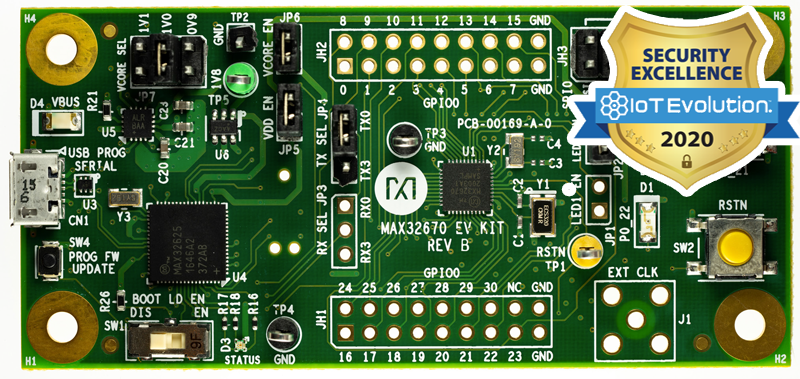
The MAX32670 evaluation kit (EV kit) provides a platform for evaluation capabilities of the MAX32670. The MAX32670 is an ultra-low-power, cost-effective, highly reliable 32-bit microcontroller that enables designs with complex sensor processing without compromising battery life. It combines a flexible and versatile power management unit with the powerful Arm® Cortex® -M4 core with floating point unit (FPU). The MAX32670 also offers legacy designs an easy and cost optimal upgrade path from 8-bit or 16-bit microcontrollers.
Applications
- Algorithm Coprocessor
- Battery-Powered Medical Devices
- Industrial Sensors
- Optical Communication Modules
- Secure Radio Modem Controller
- Smart Sensor Controller
- System Housekeeping Controller
Applicable Parts
MAX32670
High-Reliability, Ultralow-Power Microcontroller Powered by Arm Cortex-M4 Processor with FPU for Industrial and IoT
Applications
Energy Solutions
- Smart Meter Technology
Healthcare Solutions
- Therapy Device Solutions for Healthcare
- Activity Tracking and Fall Detection Solutions
- Respiration Rate Measurement Solutions
- Electrocardiogram (ECG) Measurement Solutions
- Wearable Health Monitor Solutions
- Oxygen Saturation (SpO2) Measurement Solutions
Intelligent Building Solutions
- Smoke Detection Systems
- Surveillance Camera Solutions
- Building Automation Controllers and Network Solutions
Industrial Automation
- Smart Factory IO - Link Sensor Actuator Solutions
- Smart Factory IO - Link Master Solutions
EVAL-ADPD410x-ARDZ

EVAL-ADPD4100-ARDZ and EVAL-ADPD4101-ARDZ are simple, Arduino form-factor breakout board for developing ADPD4100 and ADPD4101 applications, respectively. The ADPD4101, interfaced through I2C, and the ADPD4100, interfaced through SPI, are highly versatile, multimodal sensor front ends, stimulating up to eight light emitting diodes (LEDs) and measuring the return signal on up to eight separate current inputs.
There are a number of other evaluation platforms for these devices, including the EVAL-ADPD4100Z-PPG, optimized for photoplethysmograph applications, and the reference design CN0503, optimized for optical liquid analysis applications (colorimetry, turbidity, fluorescence). The EVAL-ADPD410X-ARDZ boards come in handy for adapting these evaluation boards to meet specific application requirements, as well as for "ground up" development of new applications.
Applications
Healthcare Solutions
- Activity Tracking and Fall Detection Solutions
- Respiration Rate Measurement Solutions
- Electrocardiogram (ECG) Measurement Solutions
- Wearable Health Monitor Solutions
- Oxygen Saturation (SpO2) Measurement Solutions
- Point of Care (PoC) Diagnostic Solutions
Instrumentation and Measurement Solutions
- Water and Air Quality Monitoring Solutions
EV-COG-AD3029
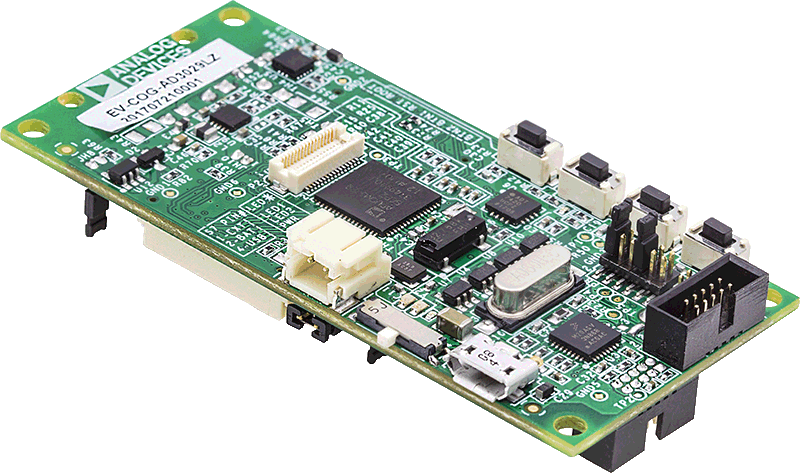
The EV-COG-AD3029 is a development platform for Analog Devices Ultra Low Power technology across ADI's MCU and RF transceiver portfolio. The board uses CrossCore Embedded Studio, an open source Eclipse based Interactive Development Environment (IDE), which can be downloaded free of charge. The platform contains many hardware and software example projects to make it easier for customers to prototype and create solutions for Internet of Things (IoT) applications.
A Cog development system may consist of these
- A MCU Cog that highlights the differentiating values of ADI ULP portfolio.
- An optional add-on board (Gear) for application specific use case.
- An optional wireless board (RF-Cog) for connectivity
The Cog development system objective is to rapidly create a development/prototyping capability focused on industrial, professional, pro-sumer customers, with a flexible radio, microprocessor, sensor and application development environment.
Applicable Parts
ADuCM3029
Ultra Low Power ARM Cortex-M3 MCU with Integrated Power Management and 256 KB of Embedded Flash Memory
ADuCM3027
Ultra Low Power ARM Cortex-M3 MCU with Integrated Power Management and 128 KB of Embedded Flash Memory
ADT7420
±0.25°C Accurate, 16-Bit Digital I2C Temperature Sensor
ADXL362
Micropower, 3-Axis, ±2 g/±4 g/±8 g Digital Output MEMS Accelerometer
Applications
Industrial Automation
- Smart Factory IO - Link Sensor Actuator Solutions
- Programmable Logic Controllers (PLC) and Distributed Control Systems (DCS)
- Predictive Maintenance Solutions
- Field Instrument Systems
Intelligent Building Solutions
- Environmental Building Monitoring Solutions
- Building Automation Controllers and Network Solutions
Healthcare Solutions
- Point of Care (PoC) Diagnostic Solutions
- In Vitro Diagnostic Solutions
- Body Temperature Measurement Solutions
- Therapy Device Solutions for Healthcare
- Computed Tomography Solutions
- Wearable Health Monitor Solutions
- Insulin Pump Solutions
- Non-Invasive Blood Pressure (NIBP) Solutions
- Electrocardiogram (ECG) Measurement Solutions
Aerospace and Defense Systems
- Military Communication Solutions
- Avionic Systems
- Unmanned Aerial Vehicles (UAV)
Instrumentation and Measurement Solutions
- Communications Test Equipment Solutions
- Signal Generator (Audio through RF) Solutions
- Radio Frequency (RF) Signal and Vector Network Analyzer Solutions
- DC Sources and Power Supply Solutions
- Precision Measurement Solutions
- Analytical Instruments
Sensor Interface Solutions
- Temperature Sensing Solutions
EVAL-ADICUP3029

The EVAL-ADICUP3029 is an Arduino and PMOD compatible form factor development board that includes Bluetooth and WiFi connectivity. The board uses CrossCore Embedded Studio, an open source Eclipse based Interactive Development Environment (IDE), which can be downloaded free of charge. The platform contains many hardware and software example projects to make it easier for customers to prototype and create connected systems and solutions for Internet of Things (IoT) applications.
The EVAL-ADICUP3029 uses the ADuCM3029 ultra low power Arm Cortex-M3 processor as the main device on board. The ADuCM3029 is an integrated mixed-signal microcontroller system for processing, control and connectivity.
Applicable Parts
Applications
Instrumentation and Measurement Solutions
- Communications Test Equipment Solutions
- Signal Generator (Audio through RF) Solutions
- Radio Frequency (RF) Signal and Vector Network Analyzer Solutions
- DC Sources and Power Supply Solutions
- Precision Measurement Solutions
Industrial Automation
- Predictive Maintenance Solutions
- Field Instrument Systems
Healthcare Solutions
- Wearable Health Monitor Solutions
EVAL-ADXL35X
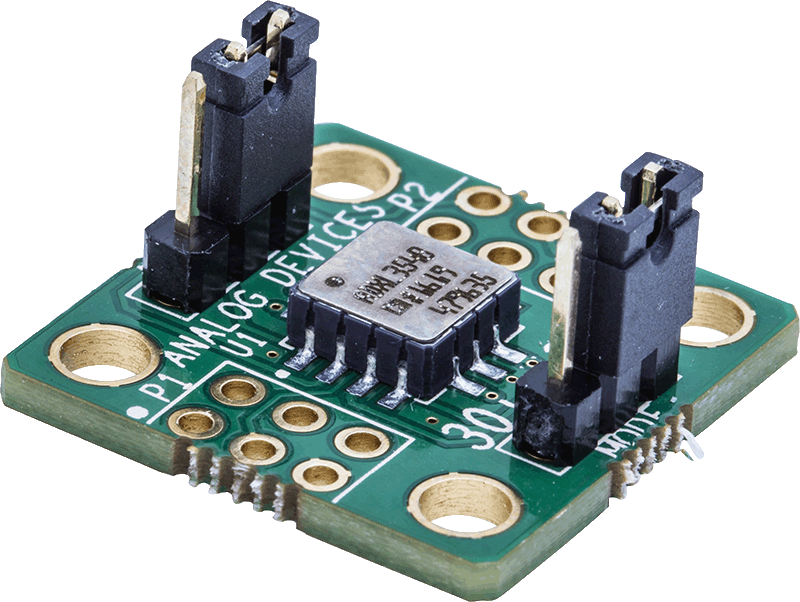
Applicable Parts
Applications
Intelligent Building Solutions
- Surveillance Camera Solutions
Industrial Automation
- Smart Factory IO - Link Sensor Actuator Solutions
- Predictive Maintenance Solutions
Instrumentation and Measurement Solutions
- Noise, Vibration, and Harshness (NVH) Automotive Solutions
Aerospace and Defense Systems
- Avionic Systems
- Military Communication Solutions
EVAL-ADXL362-ARDZ

The ADXL362 is an ultralow power, 3-axis MEMS accelerometer that consumes less than 2 μA at a 100 Hz output data rate and 270 nA when in motion triggered wake-up mode. Unlike accelerometers that use power duty cycling to achieve low power consumption, the ADXL362 does not alias input signals by undersampling; it samples the full bandwidth of the sensor at all data rates.
The ADXL362 always provides 12-bit output resolution; 8-bit formatted data is also provided for more efficient single-byte transfers when a lower resolution is sufficient. Measurement ranges of ±2 g, ±4 g, and ±8 g are available, with a resolution of 1 mg/LSB on the ±2 g range. For applications where a noise level lower than the normal 550 μg/√Hz of the ADXL362 is desired, either of two lower noise modes (down to 175 μg/√Hz typical) can be selected at minimal increase in supply current.
In addition to its ultralow power consumption, the ADXL362 has many features to enable true system level power reduction. It includes a deep multimode output FIFO, a built-in micropower temperature sensor, and several activity detection modes including adjustable threshold sleep and wake-up operation that can run as low as 270 nA at a 6 Hz (approximate) measurement rate. A pin output is provided to directly control an external switch when activity is detected, if desired. In addition, the ADXL362 has provisions for external control of sampling time and/or an external clock.
The ADXL362 operates on a wide 1.6 V to 3.5 V supply range, and can interface, if necessary, to a host operating on a separate, lower supply voltage. The ADXL362 is available in a 3 mm × 3.25 mm × 1.06 mm package
Applicable Parts
ADXL362
Micropower, 3-Axis, ±2 g/±4 g/±8 g Digital Output MEMS Accelerometer
Applications
Healthcare Solutions
- Body Temperature Measurement Solutions
- Wearable Health Monitor Solutions
- Insulin Pump Solutions
- Non-Invasive Blood Pressure (NIBP) Solutions
- Electrocardiogram (ECG) Measurement Solutions
Aerospace and Defense Systems
- Missiles and Precision Munitions
- Avionic Systems
- Unmanned Aerial Vehicles (UAV)
Reference Designs
CN0133
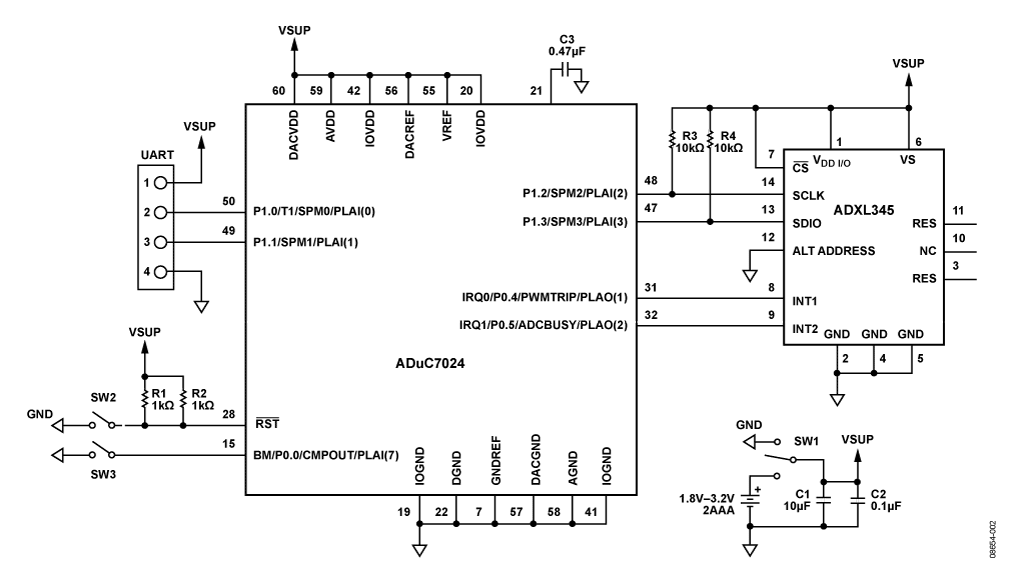
The ADXL345 is a small, thin, low power, 3-axis accelerometer with high resolution (13-bit) measurement up to ±16 g. Digital output data is formatted as 16-bit twos complement and is accessible through either an SPI (3- or 4-wire) or I2C digital interface.
The ADXL345 is well suited for mobile device applications. It measures the static acceleration of gravity in tilt-sensing appli-cations, as well as dynamic acceleration resulting from motion or shock. Its high resolution (4 mg/LSB) enables measurement of inclination changes of about 0.25°. Using a digital output accelerometer such as the ADXL345 eliminates the need for analog-to-digital conversion, reducing system cost and real estate. Additionally, the ADXL345 includes a variety of built-in features. Activity/inactivity detection, tap/double-tap detection, and free-fall detection are all done internally with no need for the host processor to perform any calculations. A built-in 32-stage FIFO memory buffer reduces the burden on the host processor, allowing algorithm simplification and power savings. Additional system level power savings can be implemented using the built-in activity/inactivity detection and by using the ADXL345 as a “motion switch” to turn the whole system off when no activity is felt and on when activity is sensed again.
The ADXL345 communicates via I2C or SPI interface. The circuits described in this document demonstrate how to implement communication via these protocols.
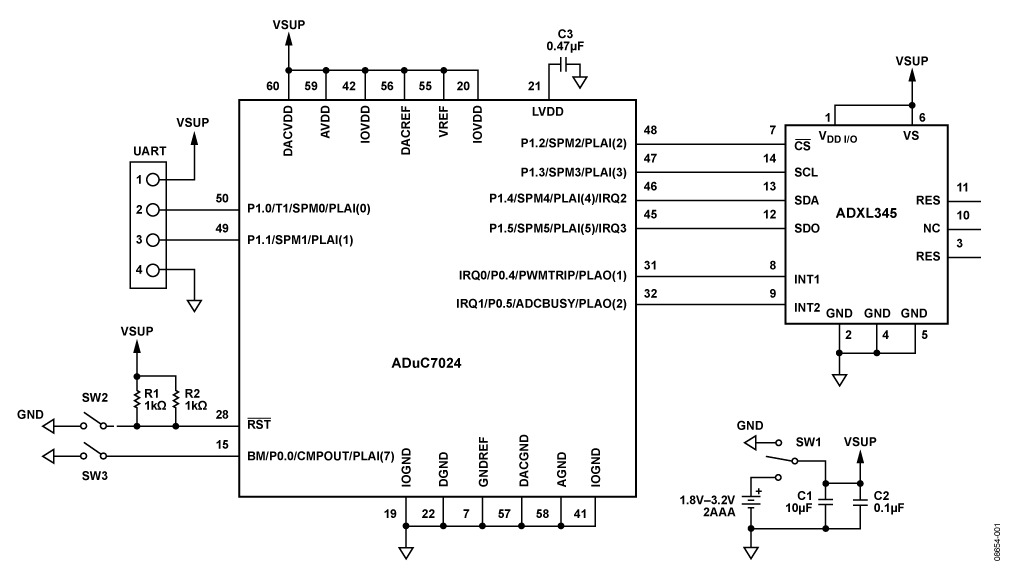
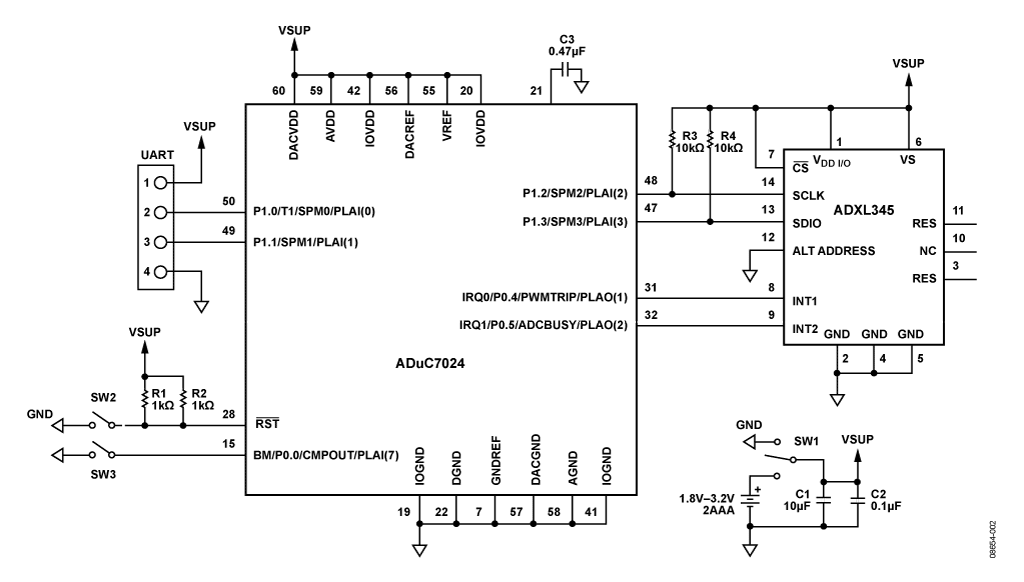
Applicable Parts
Applications
Consumer Technology Solutions
- Hearable and Wearable Solutions
Healthcare Solutions
- Respiration Rate Measurement Solutions
- Non-Invasive Blood Pressure (NIBP) Solutions
- Electrocardiogram (ECG) Measurement Solutions
- Wearable Health Monitor Solutions
- Vital Signs Monitoring Solutions
Instrumentation and Measurement Solutions
- Electronic Test and Measurement Solutions
MAXREFDES106

Description
The MAXREFDES106# Health System Platform 4.0 is a chest patch reference design that performs vital sign monitoring (VSM). The system uses high sensitivity photoplethysmography (PPG), electrocardiogram (ECG), and bioimpedance (BioZ), Temperature biosensors and algorithms measure blood oxygenation (SpO2), heart rate (HR), respiration rate (RR), impedance cardiography (ICG), body impedance analysis (BIA), and skin/ambient temperatures. The vital signs data can be streamed through low-energy Bluetooth® to a PC graphical user interface (GUI) for demonstration, evaluation, and customized development.
Applicable Parts
Applications
Healthcare Solutions
MAXREFDES104
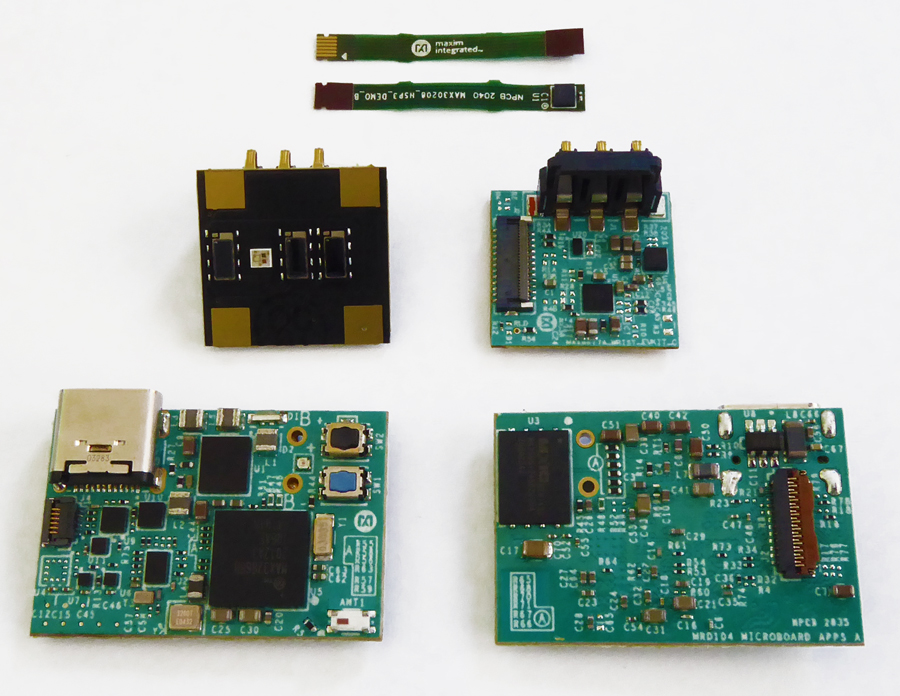
The MAXREFDES104# is a unique evaluation and development platform in a wearable form factor that demonstrates the functions of a wide range of Maxim’s products for health-sensing applications. This third-generation health sensor platform (an advancement of the MAXREFDES101# Health Sensor Platform 2.0) integrates a two-in-one PPG + ECG analog-front-end (AFE) sensor (MAX86176), a human body temperature sensor (MAX30208), a microcontroller (MAX32666), a power-management IC (MAX20360), and a 3-axis accelerometer. The complete platform includes a 3D-printed enclosure and a biometric algorithm hub with an embedded heart-rate, oxygen saturation and ECG algorithms (MAX32674). Algorithm output and raw data can be streamed through Bluetooth™ to a PC GUI for demonstration, evaluation, and customized development.
Applicable Parts
MAX86176
Ultra-Low-Power, Optical PPG and Single-Lead ECG AFE
MAX30208
±0.1°C Accurate, I2C Digital Temperature Sensor
MAX32666
Low-Power ARM Cortex-M4 with FPU-Based Microcontroller with Bluetooth 5 for Wearables
MAX20360
PMIC with Ultra-Low IQ Regulators, Charger, Fuel Gauge, and Haptic Driver for Small Li+ System
Applications
Healthcare Solutions
MAXREFDES105

Applicable Parts
Applications
Healthcare Solutions
- Activity Tracking and Fall Detection Solutions
Consumer Technology Solutions
- Hearable and Wearable Solutions
MAXREFDES282

This reference design provides information about preparing and operating the MAXREFDES282: Health Patch Platform. This platform uses high-sensitivity Photoplethysmogram (PPG), Electrocardiogram (ECG), Bio Impedance (BioZ) and temperature biosensors, and two power-management IC (PMIC) from Maxim Integrated®, now part of Analog Devices®, in a chest-patch design to capture biometric signals important for healthcare. The platform integrates algorithms to calculate those vital signs including heart rate (HR), respiration rate (RR), and blood oxygenation (SpO2) based on the biosensors measurement data. The vital signs data can be displayed on a Windows® GUI in real-time and logged to a local file for further study. This is a demonstration only reference design. The schematic, layout, and manufacturing files are not available.
Wearable and supporting documentation are available under NDA only.*
Applicable Parts
Applications
Healthcare Solutions
- Electrocardiogram (ECG) Measurement Solutions
- Body Temperature Measurement Solutions
- Oxygen Saturation (SpO2) Measurement Solutions
- Wearable Health Monitor Solutions
- Respiration Rate Measurement Solutions
Key Resources
Developer Tools and Resources
Design Tools


Simulation Models
Training and Support
Trainings and Tutorials

Video
Feb 4, 2025
02:00Hearable Solutions: More Than Audio

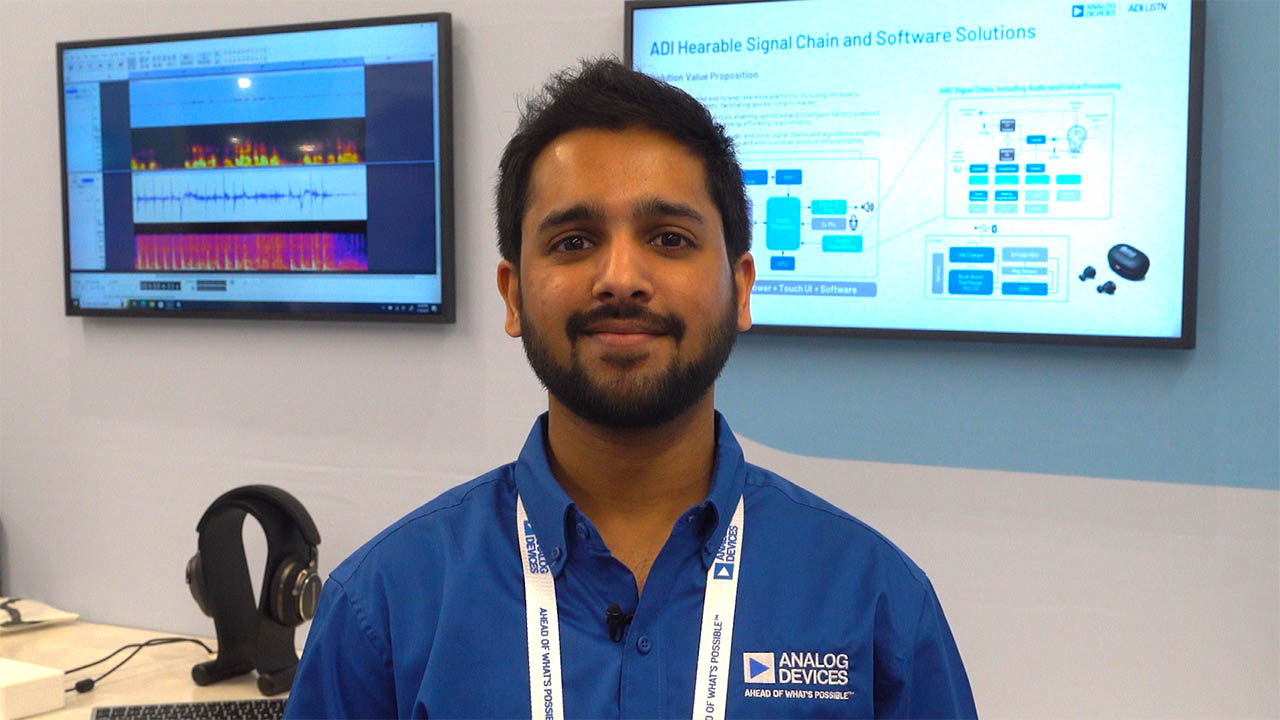
Video
Feb 4, 2025
03:02Hearable Solutions: More Than Audio


Article
Sep 10, 2024
Can a Watch Help Prevent Teen Suicide?


Article
May 22, 2024
Smart Hospital Technology in the ICU: Making Healthcare More Human

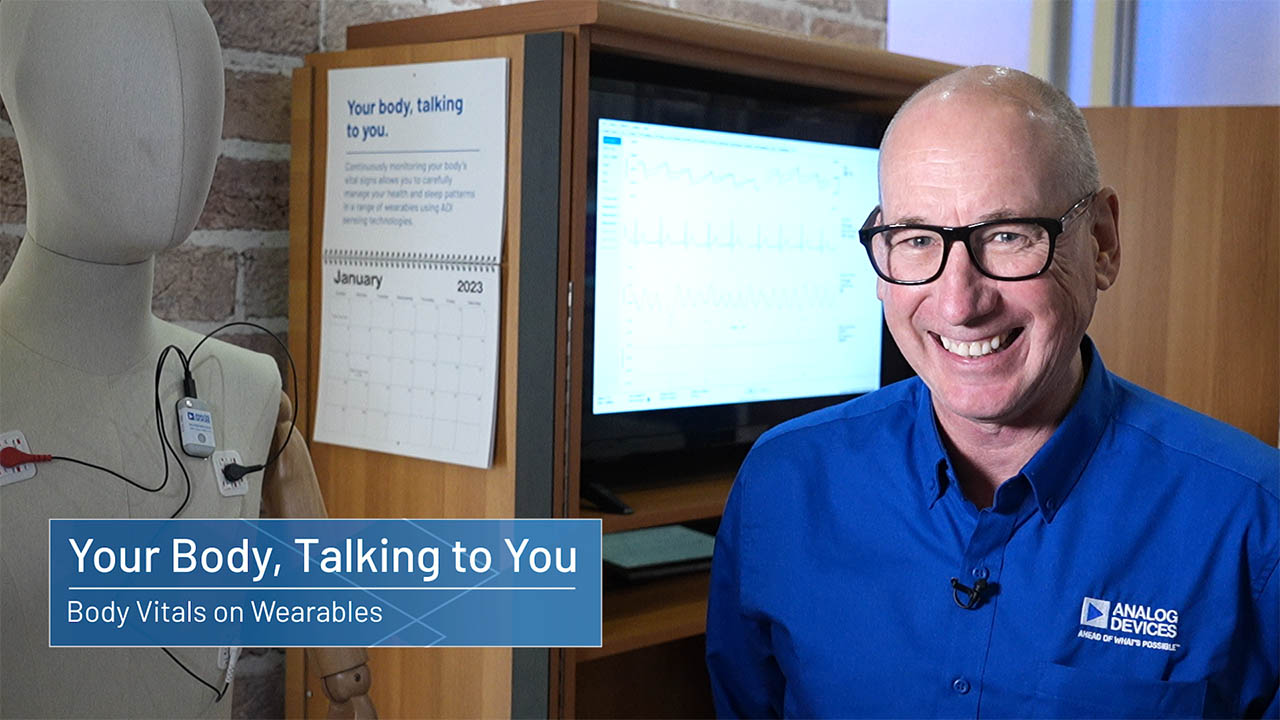
Video
Feb 8, 2023
02:38Body Vitals on Wearables: Your Body, Talking to You


Video
Sep 21, 2022
Remote Patient Monitoring: Breaking HealthCare’s Boundaries


Analog Dialogue
May 6, 2022
What Are the Best Applications for IoT in the New World of IC Power Management?


Technical Articles
Jun 1, 2021
How to Design a Better Pulse Oximeter


Thought Leadership Page
Feb 1, 2021
How Advances in Sensor and Digital Technology Yield Better Patient Care


Webcast
Nov 17, 2020
Getting Multiple Vital Signs by a Single Chip for Wearable Devices


Analog Dialogue
Nov 5, 2020
Multiparameter Vital Signs Monitoring Is Easier Than Ever Before


Video
Oct 13, 2020
Fighting Disease with Ultra-Fast Testing


Article
Oct 13, 2020
Digital Healthcare Technology Pre- and Post-Pandemic


Article
Oct 12, 2020
The Personal Impact of Continuous Glucose Monitoring (CGM) Technology


Article
Sep 14, 2020
Meiqi: Thinking Smaller to Manage Diabetes with Continuous Glucose Monitoring Devices (CGM)


Video
Sep 9, 2020
Delivering Predictive Insight to Physicians


Technical Articles
Jun 1, 2020
Vital Sign Technologies: Condition-Based Monitoring of the Human Body


Technical Articles
Apr 1, 2020
What’s in Your Healthcare Monitor?


Technical Articles
Feb 1, 2020
Wearable Market Welcomes Biomedical All-Rounder


Technical Articles
Jan 1, 2020
Close the Loop Between Wireless Charger Receiver and Transmitter Without Digital Controllers


Technical Articles
Nov 1, 2019
Wearable Technology Trends in Healthcare


Video
Oct 3, 2019
01:00ADA4625-2 Dual-Channel, 36V, JFET Input Operational Amplifier


Technical Articles
Jan 28, 2019
Robust Beat-to-Beat Detection Algorithm for Pulse Rate Variability Analysis from Wrist Photoplethysmography Signals


Webcast
Apr 20, 2018
Technologies for Wearable and Clinical Vital Signs Monitoring


Technical Articles
Jan 19, 2018
Design, Development, and Evaluation of a System to Obtain Electrodermal Activity


Technical Articles
Oct 31, 2017
Integrated Home Health Monitoring

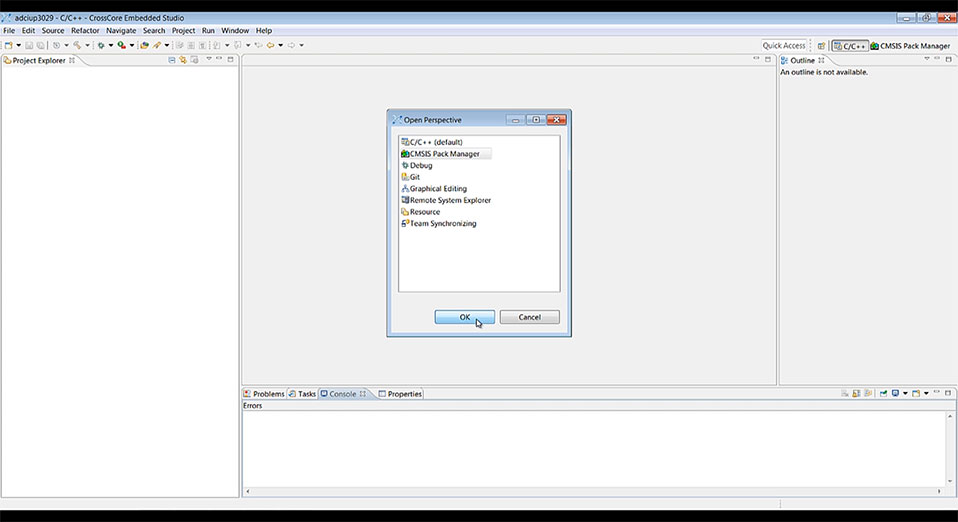
Video
Sep 25, 2017
02:55Installing device support packs for ADICUP3029

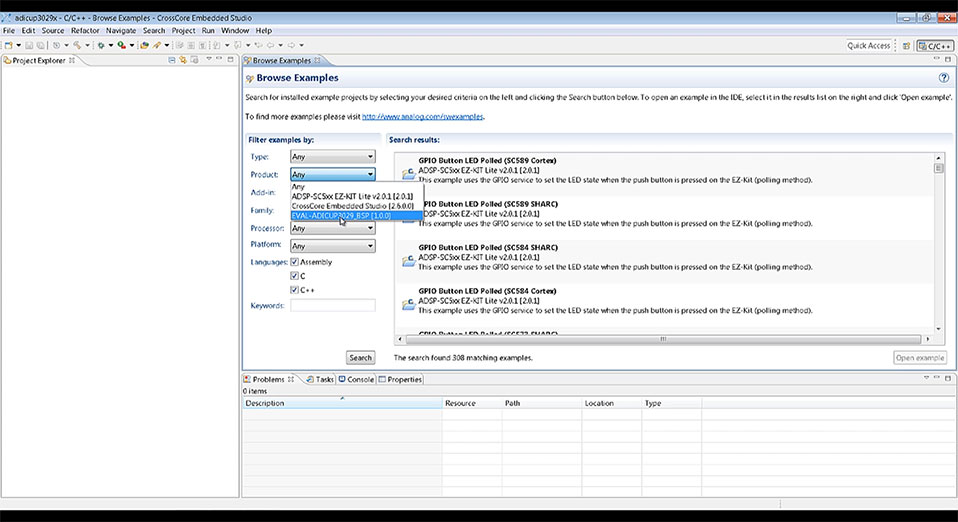
Video
Sep 25, 2017
02:39Importing ADuCM302x examples from pack files.


Video
Sep 25, 2017
03:08Importing ADuCM302x examples from Github


Video
Sep 25, 2017
02:26Creating debug configurations for the ADuCM302x

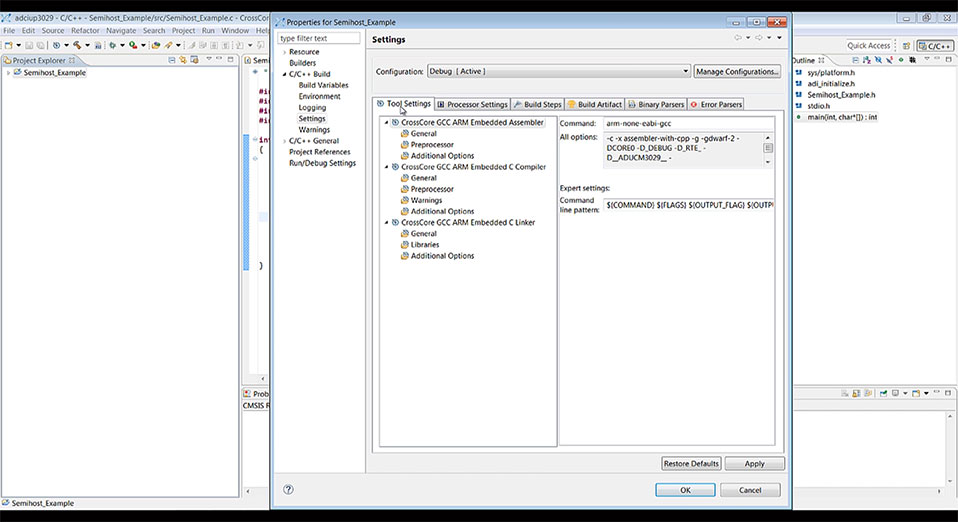
Video
Sep 25, 2017
01:42Configuring semihosting for the ADuCM302x

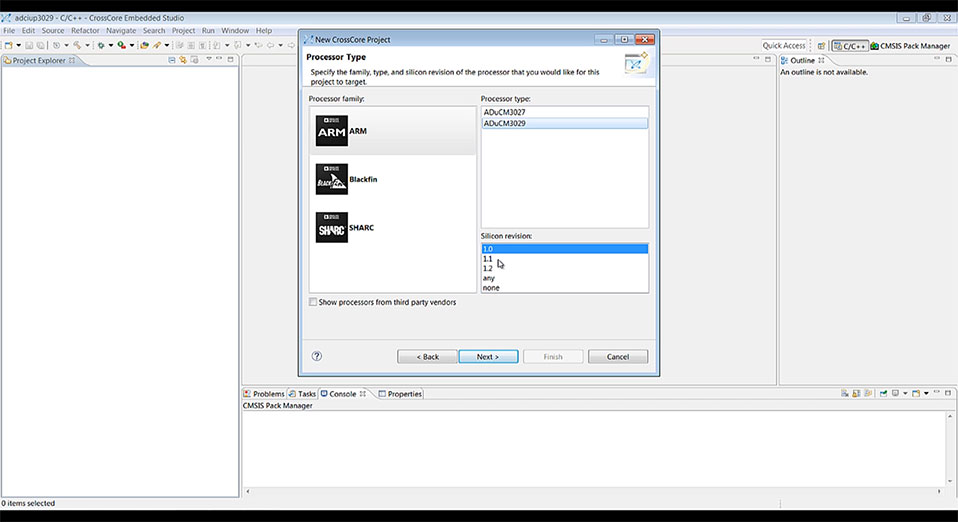
Video
Sep 25, 2017
04:36Creating custom projects for the ADuCM302x


Technical Articles
Sep 1, 2017
The Sensors Behind the GEN II Wearable Device


Thought Leadership Page
Jun 6, 2017
Transition from Wearable to Medical Devices

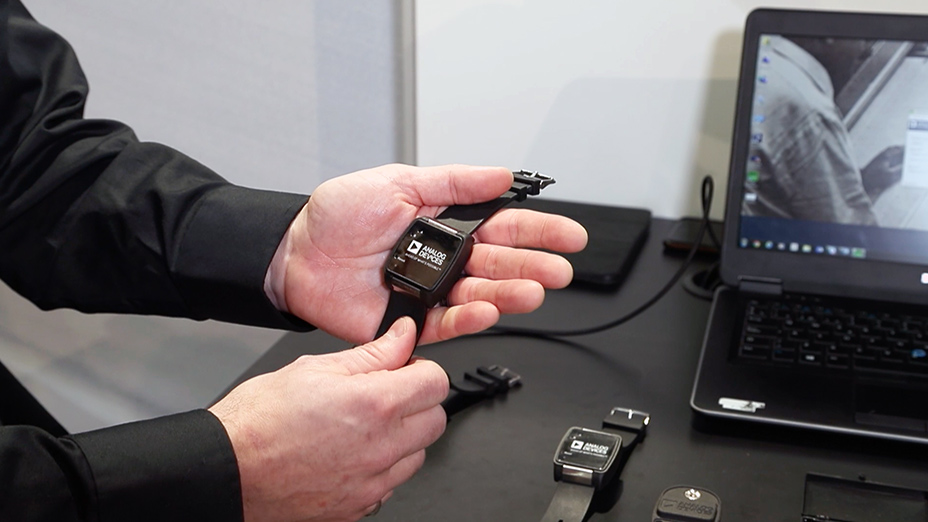
Video
Jan 19, 2017
01:44Multiparameter Wearable Vital Signs Monitoring Platform

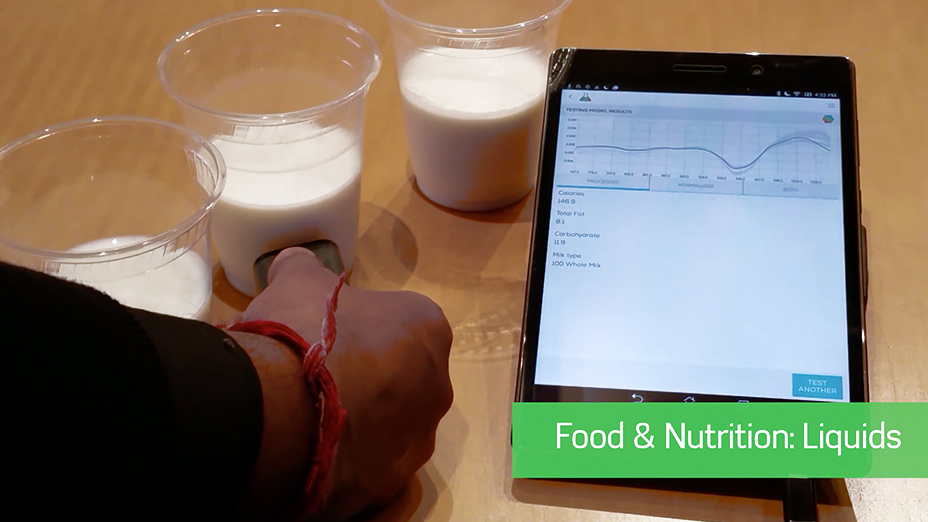
Video
Dec 5, 2016
00:34Sensing Nutrition & Substances in Milk

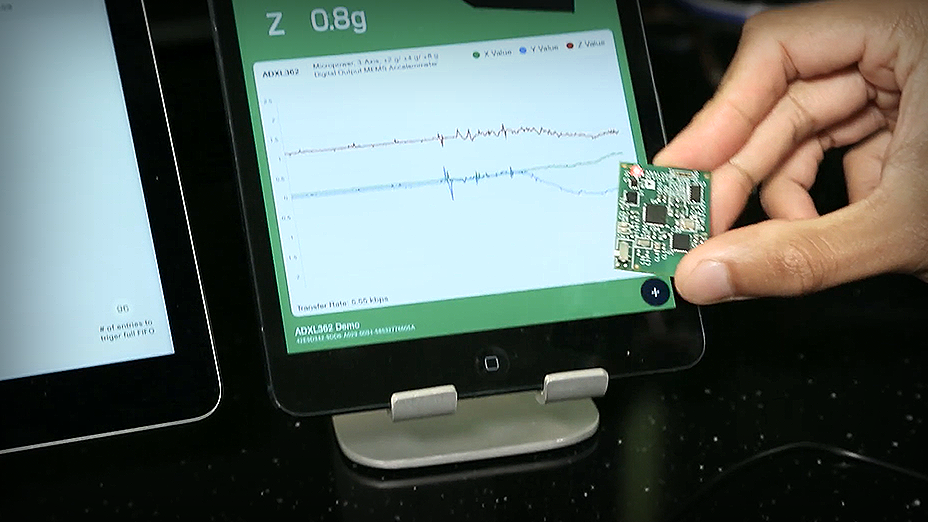
Video
Jul 12, 2016
02:00MEMS Accelerometers for Smart Infrastructure


Video
Jul 9, 2015
01:17Vital Signs Monitoring featuring LED-based Heart Rate Monitor


Video
Jul 9, 2015
01:03Vital Signs Monitoring featuring MEMS-based Pedometer


Technical Articles
May 1, 2013
"Home" Is Where the Heart Is

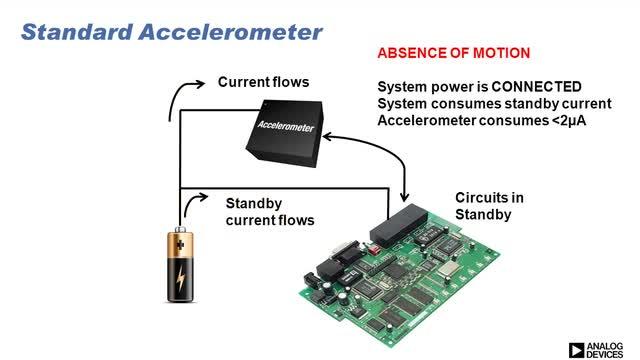
Video
May 31, 2012
03:27ADXL362 Micropower, 3-Axis, MEMS Accelerometer


Video
May 29, 2012
03:48ADXL377 MEMS Accelerometer in INDYCAR Race Car Safety System

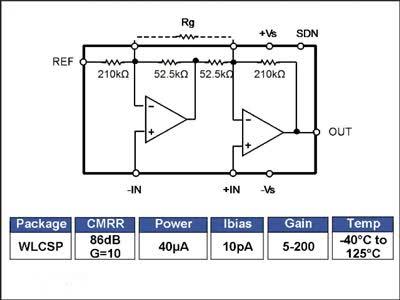
Video
Jan 20, 2011
03:37AD8235: World's Smallest Micropower Instrumentation Amplifier


Analog Dialogue
Jun 1, 2010
Full-Featured Pedometer Design Realized with 3-Axis Digital Accelerometer


Analog Dialogue
Jul 1, 2009
Detecting Human Falls with a 3-Axis Digital Accelerometer

Files and Downloads

Technologies for High Performance Portable Healthcare Devices
598.17 K

ADAS1000 5-Electrode ECG AFE
595.84 K

UG-1091: How to Set Up and Use the ADuCM3027/ADuCM3029
1.67 M

ADP5350: Advanced Battery Management PMIC with Inductive Boost LED and Three LDO Regulators Data Sheet
1.68 M

The Building Blocks of the IoT
1.83 M

ADXL372: Micropower, 3-Axis, ±200 g Digital Output, MEMS Data Sheet
2.59 M

AN-1452: ADuCM3027/ADuCM3029 Flash EEPROM Emulation
151.88 K

Silent Switcher Technology
1.74 M

Understanding Silent Switcher Technology: High Efficiency, Low EMI eBook
7.75 M

Ultralow Power Voltage Regulator, Supervisory, and PMIC
2.81 M

ADGS1612: SPI Interface, 1 Ω RON, ±5 V, 12 V, 5 V, 3.3 V, Mux Configurable, Quad SPST Switch Data Sheet
373.21 K

CN0407: Ultrahigh Sensitivity Femtoampere Measurement Platform
548.59 K

Precision Products and Signal Chain Solutions: Selection Guide 2019
13.38 M

CN0370: 16-Bit, Single-Supply LED Current Driver with Less than ±1 LSB Integral and Differential Nonlinearity
232.9 K
Show More
ADI Support
Let us know what you need help with, and we will share the best answers from the ADI knowledge database.
Get Help
{{modalTitle}}
{{modalDescription}}
{{dropdownTitle}}
- {{defaultSelectedText}} {{#each projectNames}}
- {{name}} {{/each}} {{#if newProjectText}}
-
{{newProjectText}}
{{/if}}
{{newProjectTitle}}
{{projectNameErrorText}}
